LAST UPDATED: 1/31/24 – Galápagos Islands Wildlife Guide
The Galápagos Islands are one of this world’s most famous, and alluring, wildlife destinations. Ever since Charles Darwin visited the islands, people have been flocking there to see this amazing ecosystem. His theory of Evolution and the animals he studied piqued a curiosity that only visiting could itch.
The Galápagos Islands have a staggering array of marine wildlife in its waters. However, there are also a wide variety of birds, reptiles, and mammals found on the islands themselves. I cover all of these animals and more in this Galápagos Islands wildlife guide.
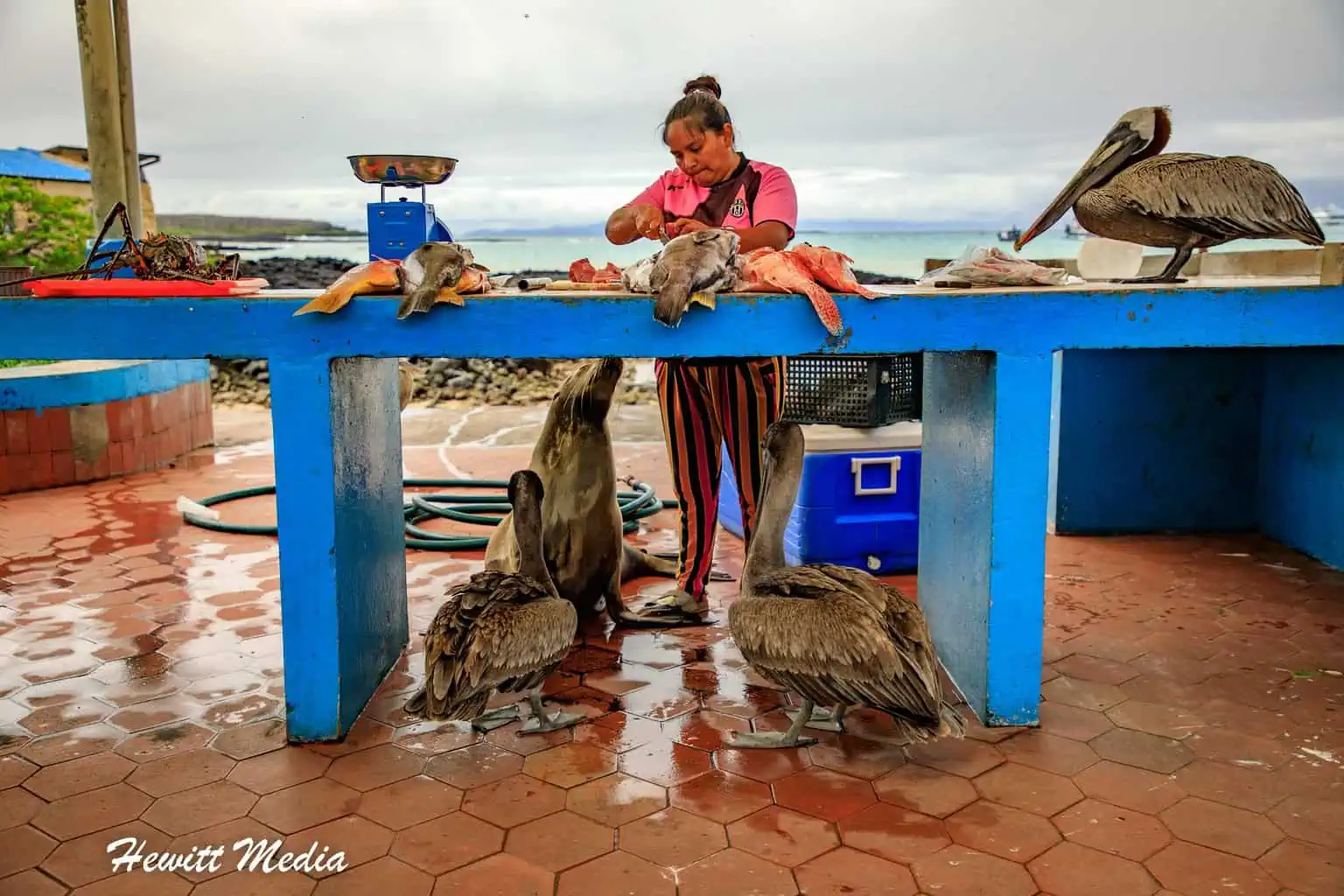
In this Galápagos Islands wildlife guide, I highlight some of the wildlife that the Galápagos is most well known for. With this guide, you will be better prepared to locate, identify, and enjoy the amazing wildlife of the islands.
Galápagos Wildlife Guide Navigation Menu
| Wildlife Safety | |
| Protecting the Galápagos Ecosystem | |
| Wildlife Events | |
| Wildlife Found in the Galápagos | |
| Charles Darwin Research Center | |
 |
Galápagos Islands Wildlife Photo Gallery |
Wildlife Safety
The Galápagos Islands are a protected area. That means the animals within the Galápagos Islands preservation areas are as well. When you visit, you are responsible for following the rules that are designed to protect these animals. In addition to not feeding the animals, you must stay at least 6 feet away from the animals whenever possible.

Sometimes this can be difficult to do. There may be a Galápagos Sea Lion or Marine Iguana resting in the middle of a path or dock. In these cases, it can be hard to find a way around them without getting close. When this happens, please listen to the instructions of your naturalist guides. They will help make sure that not only the animals remain safe, but you remain safe as well.
Protecting the Galápagos Ecosystem
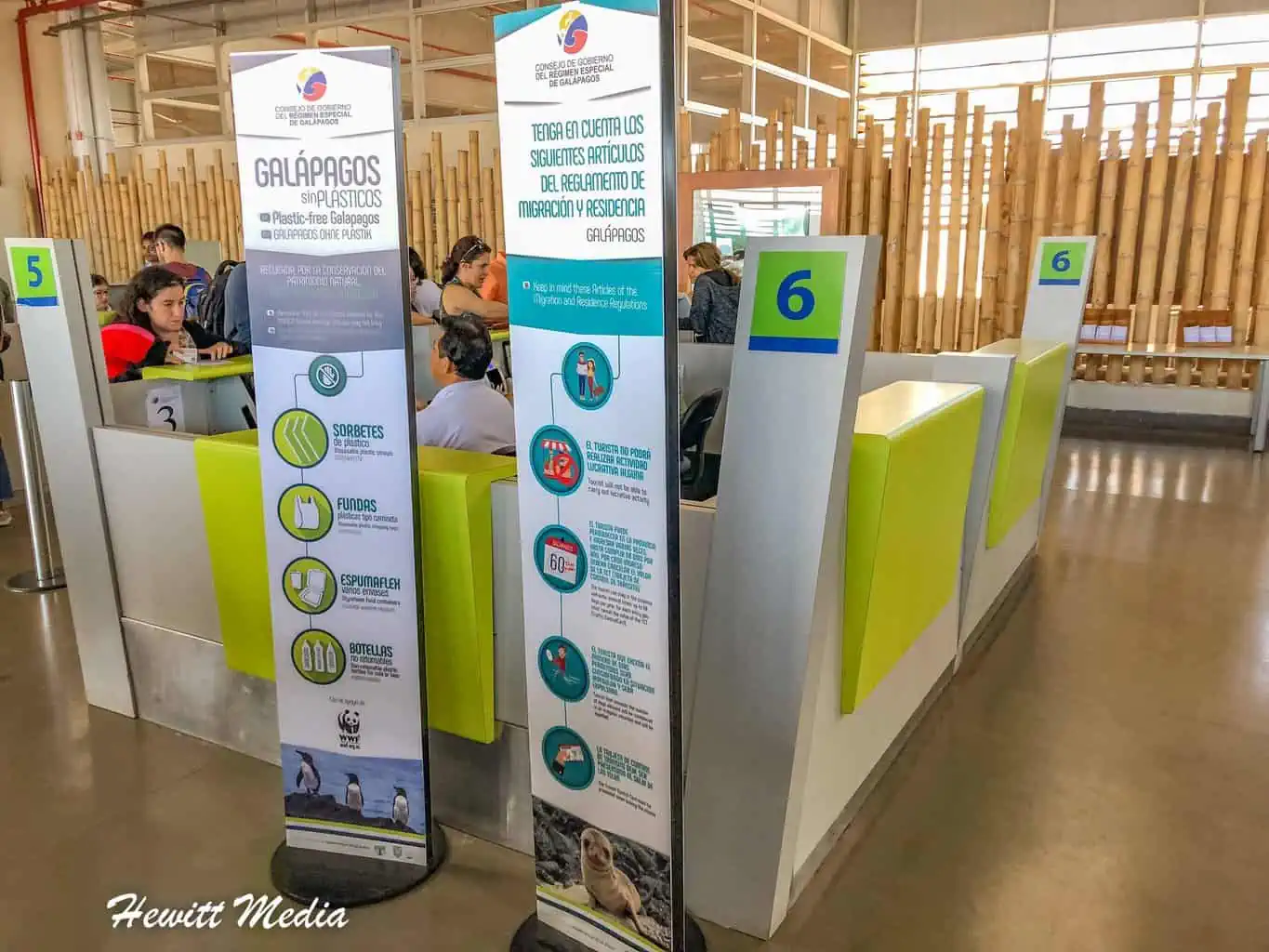
With great beauty comes great responsibility. The Galápagos Islands are an incredibly beautiful and diverse ecosystem, but they are also a very fragile ecosystem. As a visitor, you are responsible for following the rules and guidelines.
These guidelines are designed to help protect the Galápagos for future generations. If you would like to review the rules and guidelines, I have you covered. I included a highlighted list in my Galápagos Islands wildlife guide below. However, I would also recommend you read the full list of rules and regulations before visiting.
Overview of the Rules and Regulations
- You must be accompanied by a naturalist guide while in protected areas.
- Practice trail etiquette by staying on marked trails and obeying trail signs.
- Stay at least 6 feet away from the wildlife at all times.
- Refrain from using flash photography at all times.
- Only camp in authorized areas with the proper permit.
- It is your responsibility to not introduce foods, plants, or animals on the island.
- Do not take any souvenirs from the islands (plants, rocks, coral, animal parts, etc.)
- Practice “leave no trace” at all times.
- Smoking and the use of campfires is prohibited at all times.
- Fishing is only permitted on recreational tour boats.
- Motorized aquatic sports are prohibited.
Wildlife Events
There is a staggering assortment of interesting wildlife events that occur in the Galápagos Islands. This can make it difficult at times to plan a trip. You may be wondering what time of year it would be best for you to visit.
For those who are unsure, I have developed a Wildlife Event Infographic to assist you. You can find that in my Galápagos Islands wildlife guide below. This Infographic highlights many of the important wildlife events that occur on and around the islands.
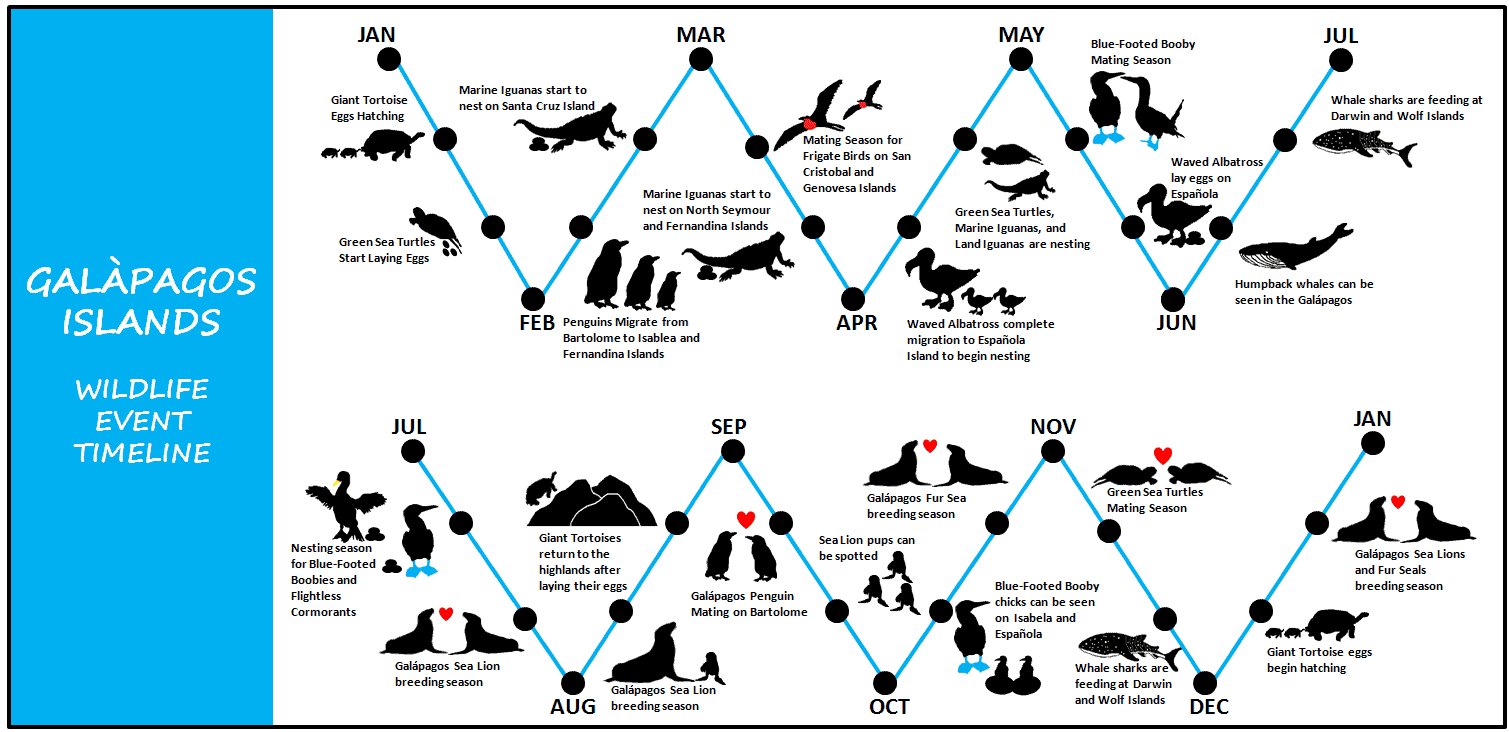
Wildlife Found in the Galápagos

The Galápagos Islands are a unique and fantastic destination. However, it isn’t just because of the breathtaking vistas. In addition, the islands are also home to an amazing diversity of unique wildlife. For those who are curious as to which animals you might see, you will want to read on. I cover some of the more common animals in my Galápagos Islands wildlife guide below.
Giant Tortoise
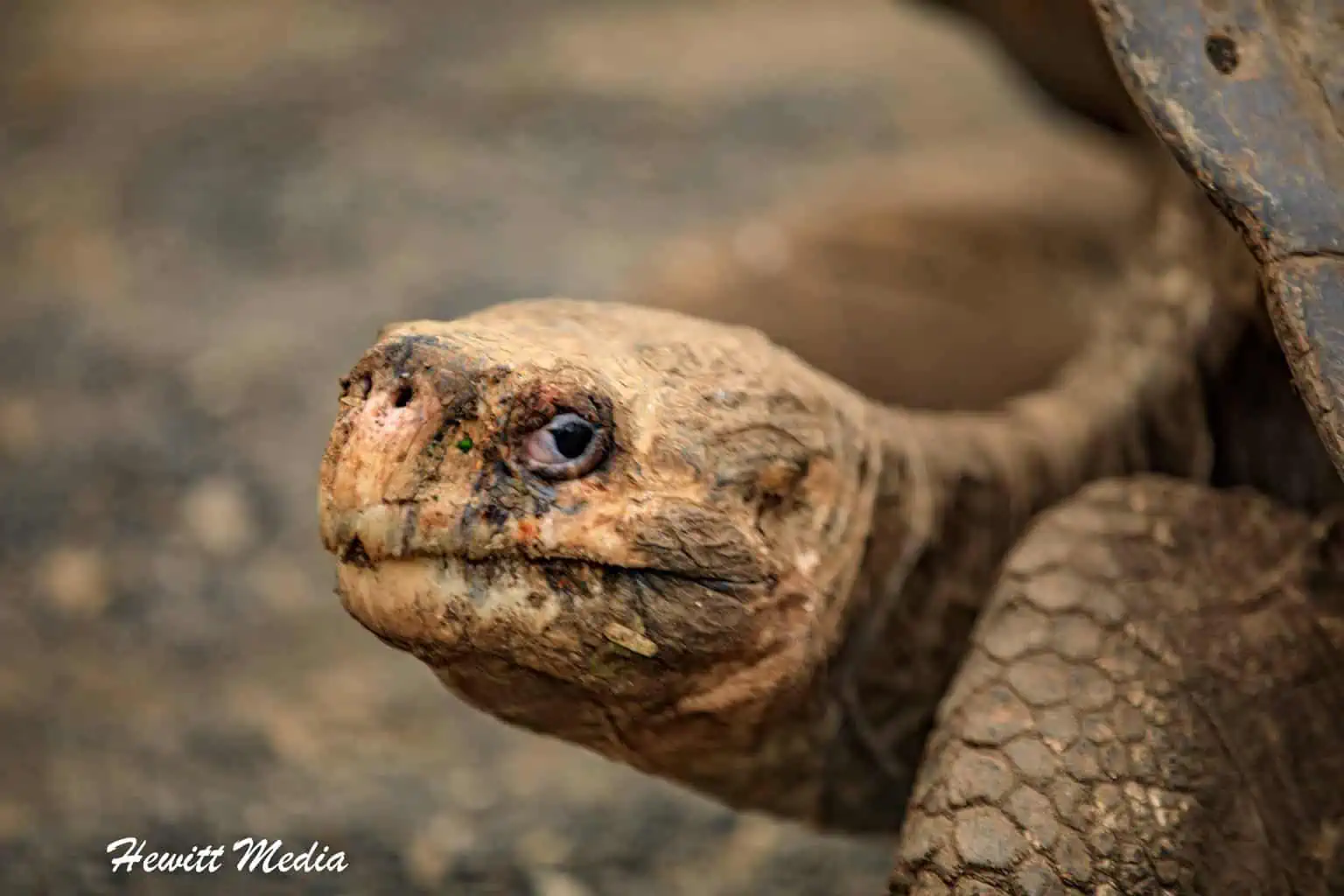
One can argue that no other animal has come to symbolize the Galápagos Islands as much as the giant tortoises. In fact, the name Galápagos is derived from the old Spanish word galapago, which translates to mean “saddle”. The early Spanish explorers used this term to describe the shape of the tortoises’ saddle-like shells.
One of Only Two Groups of Giant Tortoises in the World
Today the giant tortoises of the Galápagos are one of only two remaining groups of giant tortoises in the world. The other group is located on the Aldabra Atoll in the Indian Ocean. These magnificent creatures that once roamed throughout the world are now isolated to these two small pockets on remote islands.
It is thought that the tortoises arrived in the Galápagos aboard vegetation rafts. They first colonized the Eastern islands of Española and San Cristóbal. Soon after, they dispersed to form 15 different populations on 10 different islands in the Galápagos.
Only 9 Species of Galápagos Giant Tortoises Remain
Two of the thirteen species of giant tortoise in the Galápagos Islands have gone extinct. Their loss was the result of excessive exploitation of the species and habitat destruction. An additional species is thought to have gone extinct on its own. This leaves 9 current species of Galápagos giant tortoises still in existence in the Galápagos Islands today.
There is an effort underway to breed the giant tortoises. Three active breeding centers throughout the islands currently breed tortoises. The goal is to prevent future extinctions. In addition, the authority that oversees the Galápagos Islands has placed strict controls on plants and animals allowed onto the islands. These steps are critical in protecting native species such as the Galápagos giant tortoise. With no natural predators, mankind really is their worst threat.
You Can See Them at the Breeding Centers and in the Wild
The breeding centers on Santa Cruz, Isabela, and San Cristóbal islands aren’t the only places to see giant tortoises. You can also take a tour into the highlands one one of these islands to see them in their natural habitat. That is where the oldest and the largest giant tortoises live. It is absolutely spectacular to see these wonderful animals in their natural habitat.
In addition, the Charles Darwin Research Center on Santa Cruz Island is an absolute must-stop as well. This is the best place to learn more about the Galápagos giant tortoises. You will also learn a lot about the conservation efforts underway to protect these and other amazing animals.

Galápagos Penguin
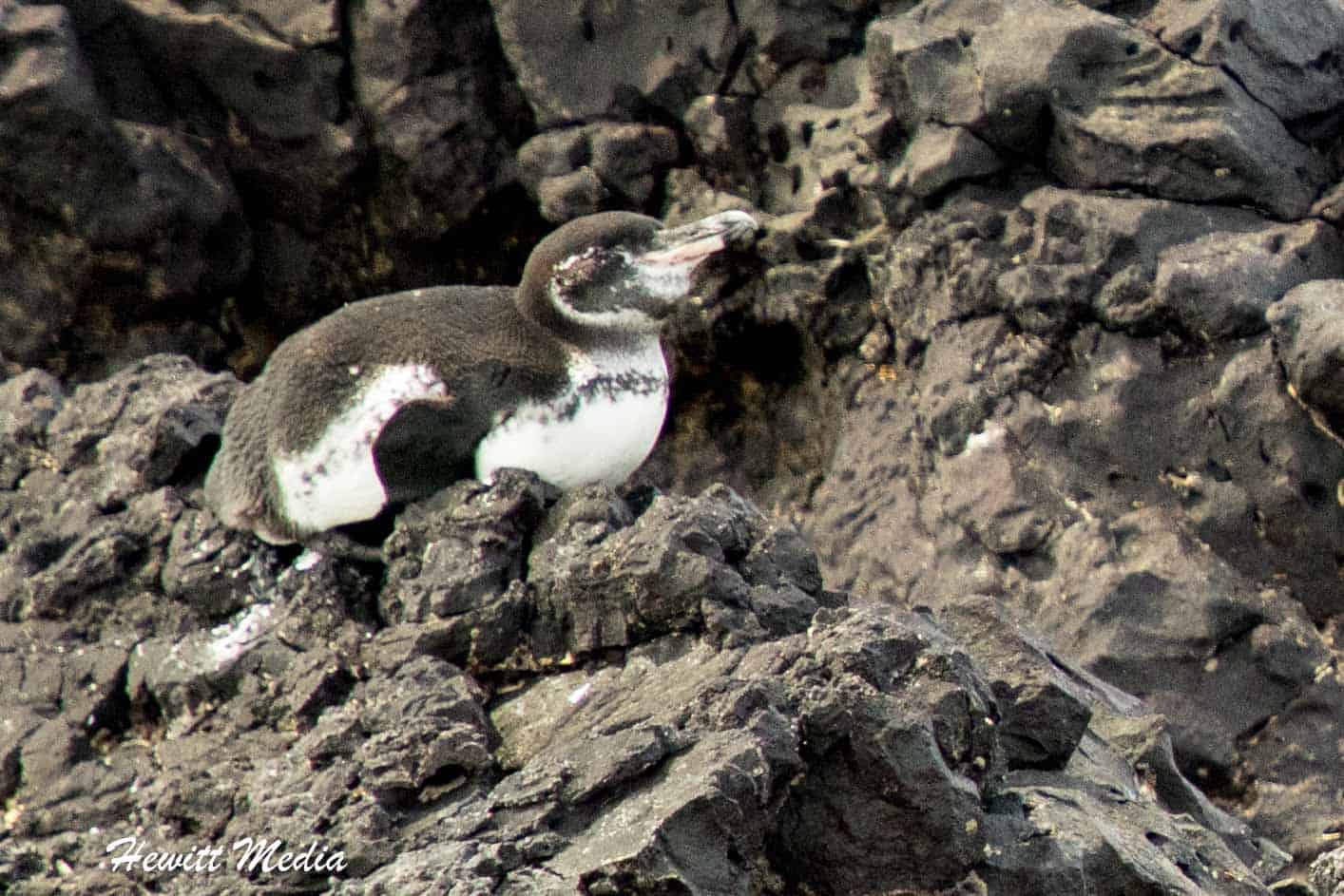
My favorite animal of the Galápagos Islands is one you wouldn’t think would exist there at all. The Galápagos penguin is remarkable for being one of the smallest penguins on the planet. However, it is also remarkable because it is the only penguin to exist North of the Equator.
They are without a doubt my favorite animal in the Galápagos Islands to see in action. While clumsy on land, they are one of the most graceful swimmers you will find on the islands.
They Are Found Primarily Around Fernandina and Isabela Islands
The Galápagos penguins are found primarily around Fernandina Island and the west coast of Isabela Island. However, small populations can also be seen around Santiago, Bartolomé, northern Santa Cruz, and Floreana Islands as well.
These penguins can live close to the Equator because of the cold Humboldt current from Antarctica. This is why you will typically see the birds in the water when it is warm out.
If you are interested in swimming with the Galápagos penguins, you are in luck. There are several snorkeling expeditions that I outline in my Galápagos Islands Scuba Diving and Snorkeling Guide. These expeditions allow you to get up close and personal with these amazing creatures.
The best snorkeling site, without a doubt, is the Tagus Cove snorkeling site, just off Isabela Island. It sits in between Isabela and Fernandina Islands, which is a hot spot for penguin activity.

Marine Iguanas
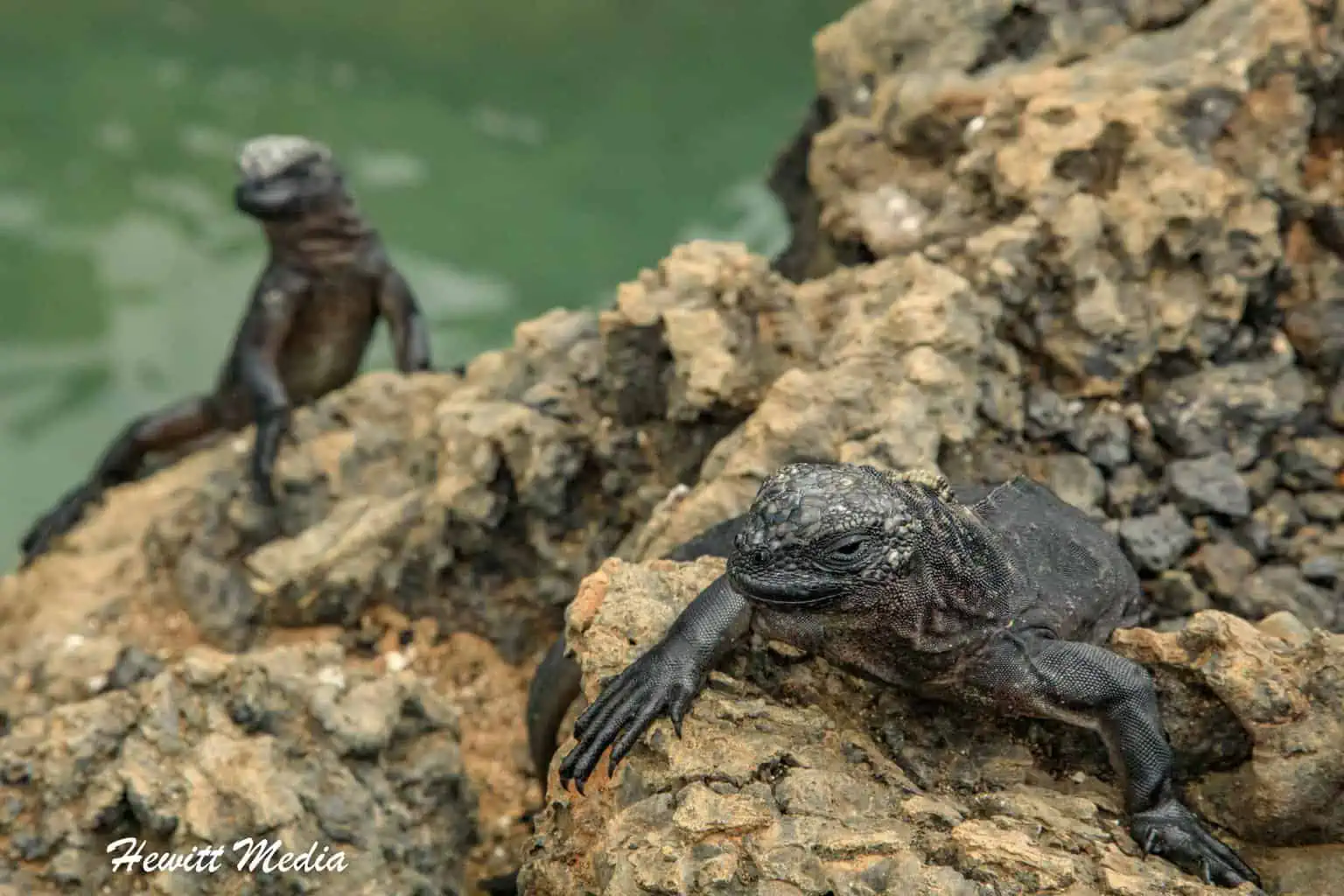
You will be hard-pressed to find a more unique and interesting creature in the Galápagos Islands than the marine iguana. They aren’t the cutest-looking animals.
In fact, Charles Darwin once said that they are “hideous-looking” and the “most disgusting, clumsy lizards”. However, what they lack in beauty they surely make up for in uniqueness.
They Are the Only Iguanas in the World That Dive
These swimming iguanas are the only iguanas in the world that submerge themselves in the water and dive. They do so to feed on the algae that grow on the rocks that are submerged just off the coastline.
Because they are cold-blooded, they must heat their bodies up after diving for their breakfast. Because of this, you will often see them lounging on the rocks in the sun for most of the day.
When the iguanas are young, they are at risk from predators such as the Galápagos Hawk. So, the young iguanas will typically hang out in the volcanic rocks near the lava tunnels. Here, they can quickly hide if threatened.
Las Tintoreras is a Great Place to See Them
If you visit Las Tintoreras to snorkel, you’ll see hundreds of juvenile marine iguanas near the lava tunnels. For those interested, I highlight these tours in my Galápagos Islands Scuba Diving and Snorkeling Guide.
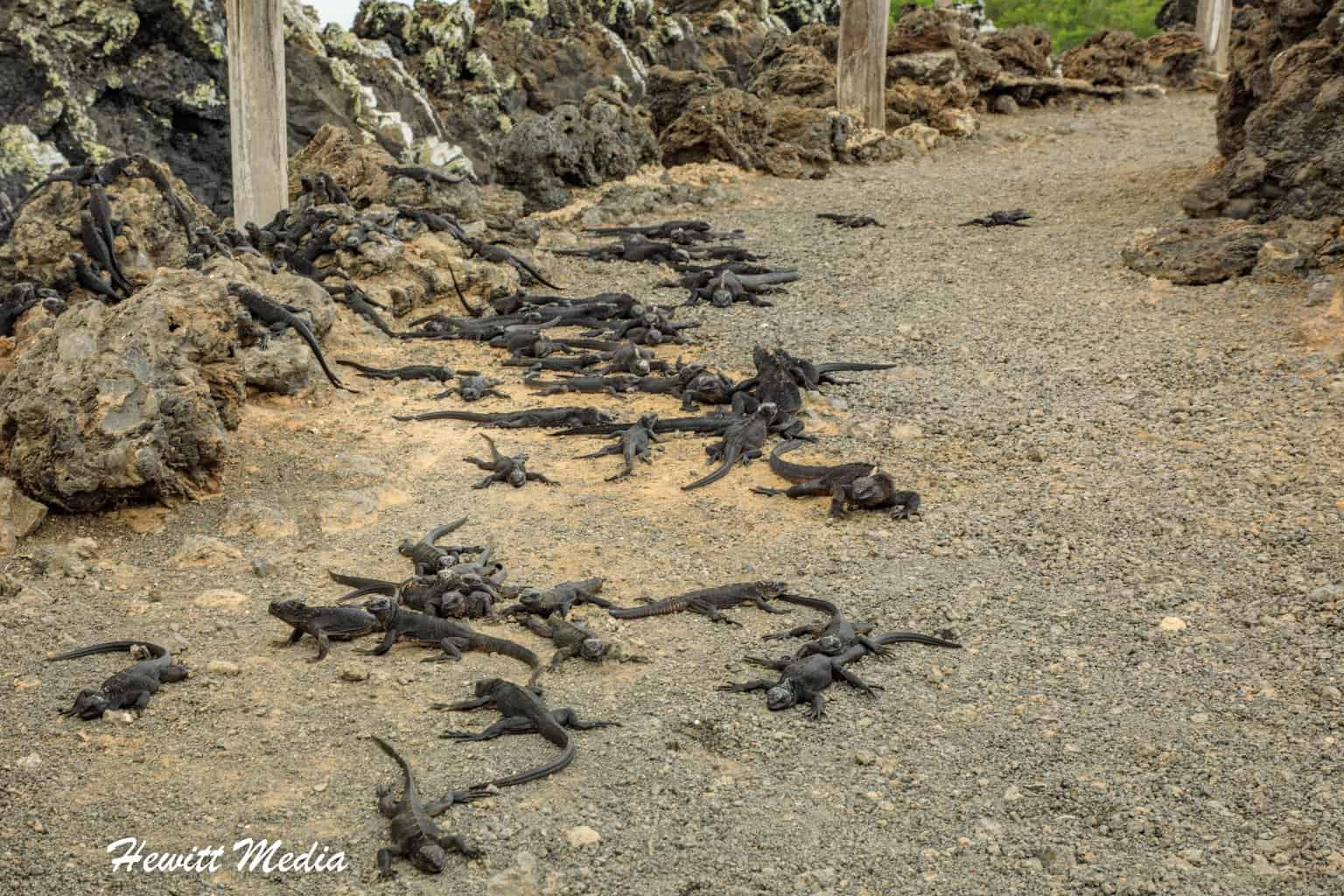
Once the iguanas get bigger and can defend themselves, they will venture out of these locations. You will often see older adult marine iguanas dispersed about the islands. To see them swimming and feeding, you will need to visit certain snorkeling locations.
Another Great Place to See Marine Iguanas is at Punta Espinosa and Tagus Cove
To see the marine iguanas swimming and feeding, you will want to visit the Punta Espinosa and Tagus Cove snorkeling sites. These sites are located off of Isabela Island. For more information, see the map I included in my Galápagos Islands wildlife guide below.
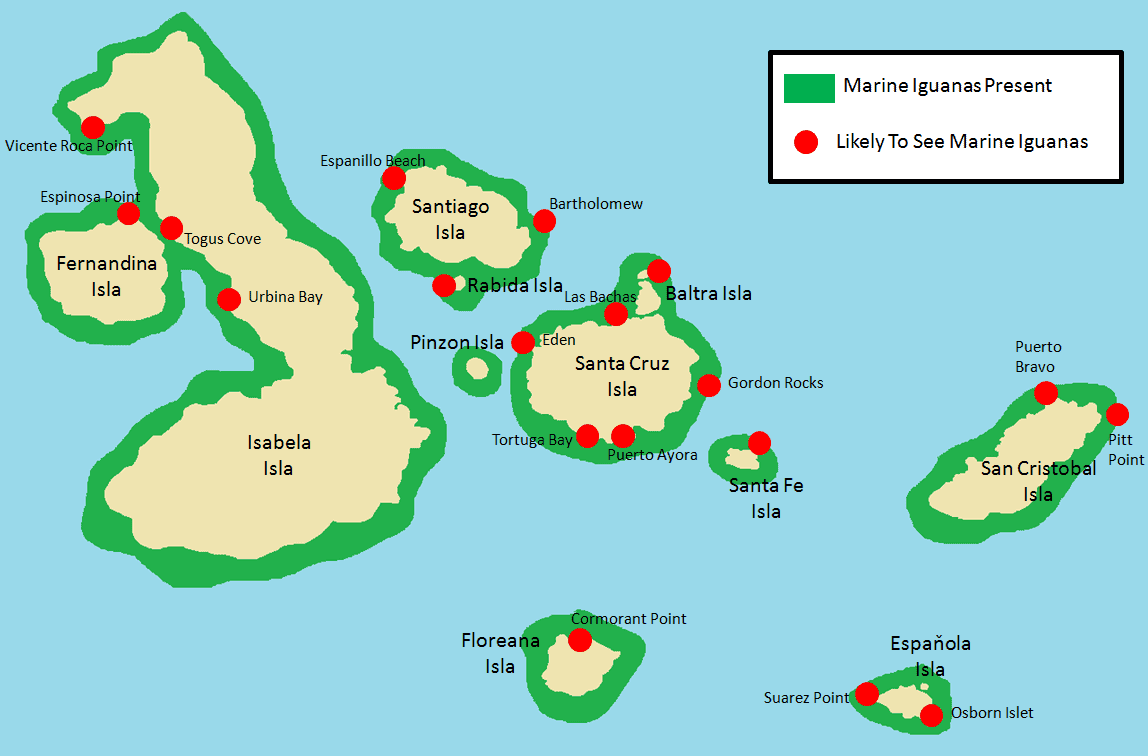
Land Iguanas

There are three different species of land iguana found in the Galápagos Islands. Among them, the most well-known are the yellowish iguanas.
The first species of land iguana is the Conolophus subcristatus species. These iguanas are native to six different islands in the Galápagos. There is also the Conolophus pallidus species, which can only be found on the island of Santa Fe.
The third species of land iguana is the Conolophus marthae species. This species of land iguana wasn’t discovered until 1986 or studied until the early 2000s. Known for being a pinkish and black color, they often have stripes. These beautiful iguanas can only be found on the Wolf volcano on the Northern end of Isabela Island.
Land iguanas are herbivores, so they only feed on plants. Their primary food sources are low-hanging plants and shrubs, as well as fallen cacti pads. The iguanas will typically rest in the shade during the day and then retreat to burrows in the earth at night.
They Are Typically Found Beneath Cactuses and Shrubs
Your best bet for seeing these wonderful creatures is to look beneath cactuses and shrubs. You will often find them searching for their next meal or escaping the hot mid-day sun. For more information, please refer to the map I have included in my Galápagos Islands wildlife guide below.

Galápagos Sea Lions
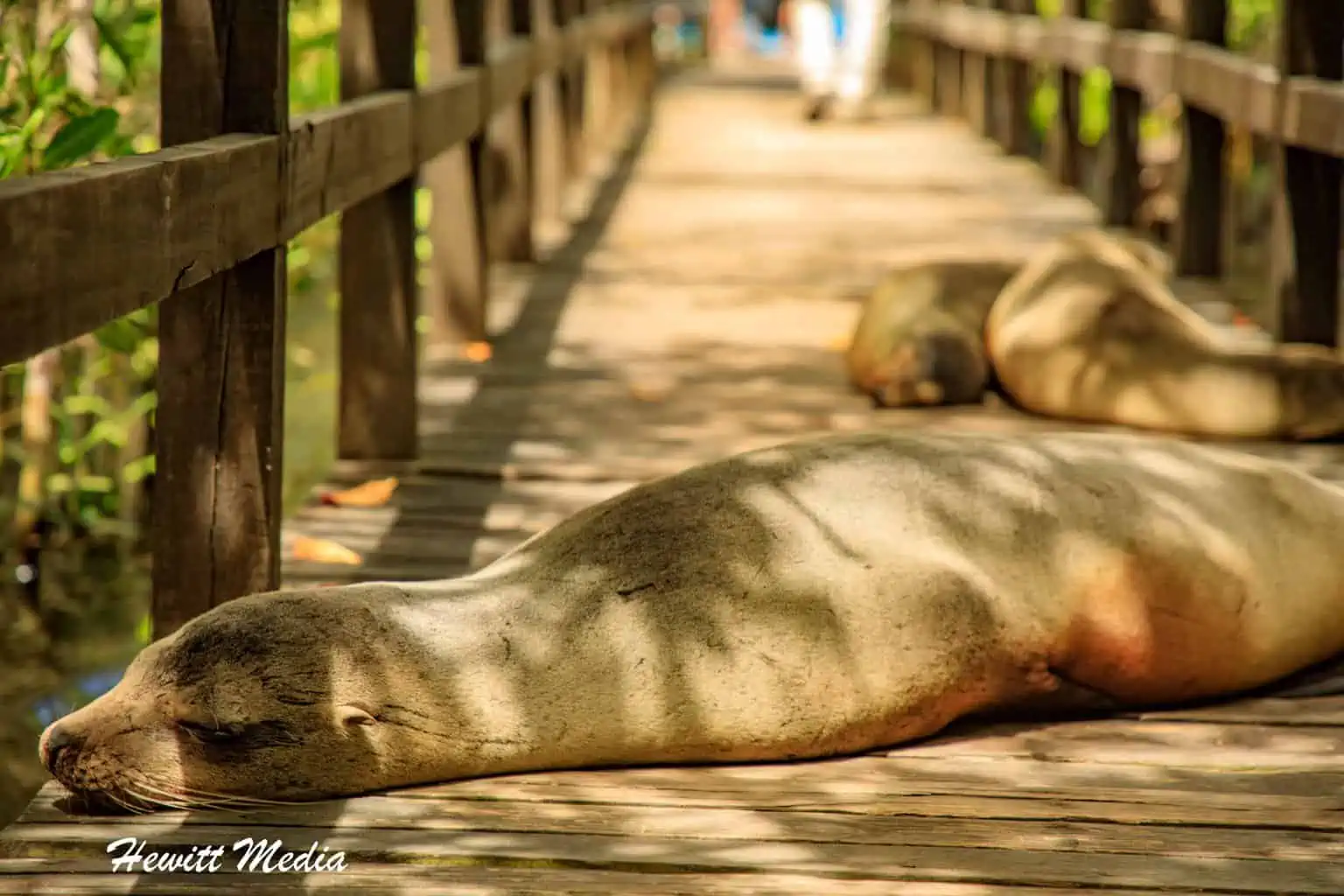
Galápagos Sea Lions can be seen throughout the Galápagos Islands but are most typically seen on beaches and rocky shorelines. The sea lion breeding season occurs between June and December. So, if you want to see a newborn pup, I recommend visiting between March and May.
You Will See Them a Lot Around the Harbors
You will often see numerous sea lions around the harbor. This is especially true at Puerto Ayora on Santa Cruz Island and in Puerto Villamil on Isabela Island. They are also often found lying on benches, docks, and other platforms. Here, they can bask in the sun and relax.
Isla Lobos Off San Cristobal is a Great Place to Swim with Them
For those who would like to swim with sea lions, your best bet is a snorkeling tour. The best one to book is at the Isla Lobos snorkeling site off of San Cristobal Island. Without a doubt, this is the best place to swim with sea lions in the Galápagos Islands.
Although the best, it isn’t the only site where you can swim with sea lions. I cover some additional locations in my Galápagos Islands Scuba Diving and Snorkeling Guide.
NOTE: Don’t confuse the Galápagos Sea Lion with the Galápagos Fur Seal. The fur seals live around the islands as well but are seldom seen. Although they travel amongst all the islands, they are mostly seen in just a few spots. This includes James Bay on Santiago Island and in Darwin Bay on Genovesa Island.

Galápagos Hawk
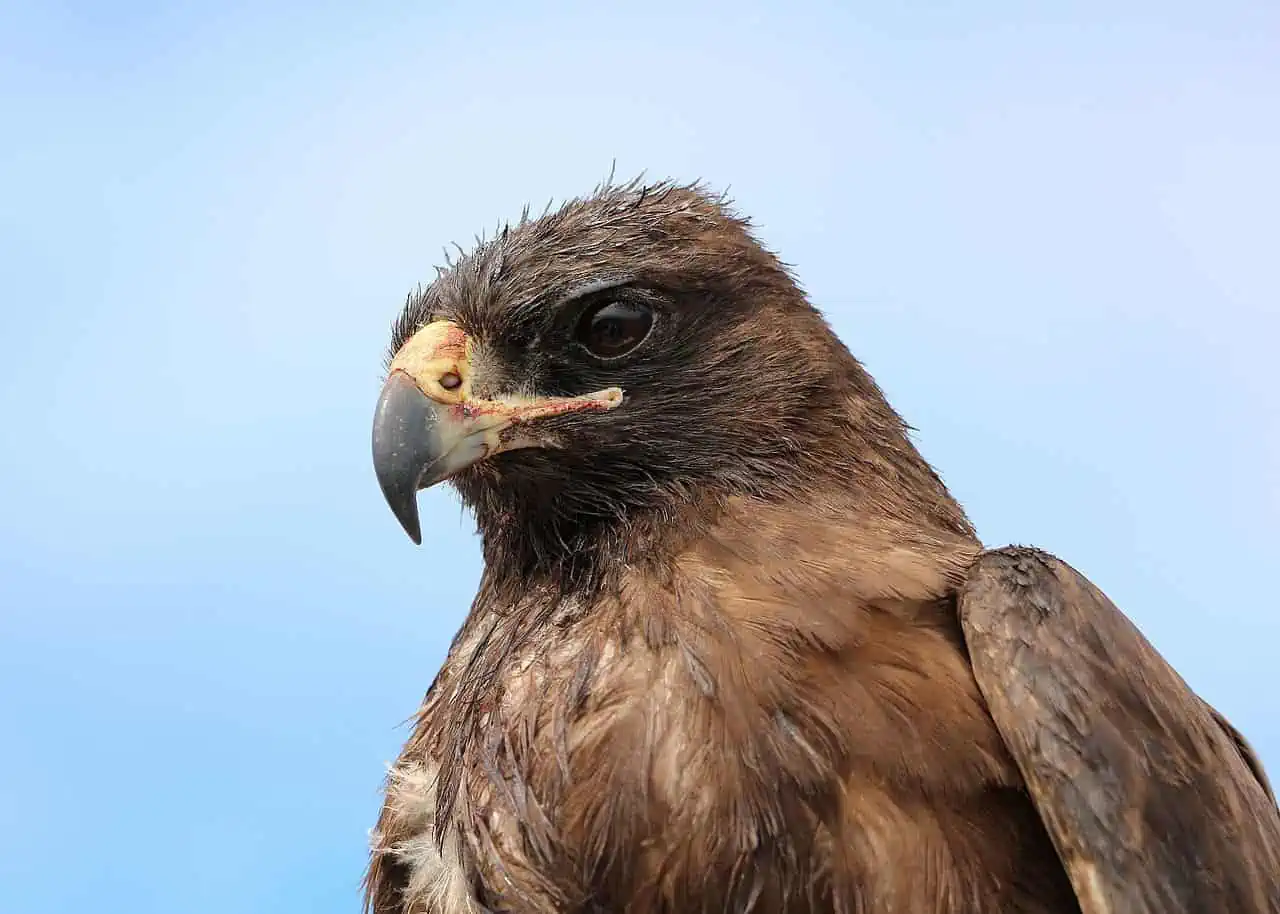
The Galápagos hawk is one of the top predators in the Galápagos Islands. These amazing birds are endemic to the Galápagos. However, they are closely related to the American white-tailed and red-backed hawks. They are one of the world’s rarest raptors, so seeing one is special. It is believed that as few as 150 breeding pairs exist in the wild today.
Galápagos hawks feed primarily on large insects such as centipedes and locusts. However, they will also consume small rodents, snakes, lizards, and turtle hatchlings. The hawks can be found mostly on Isabela and Fernandina islands. Unfortunately, they have gone extinct on the islands of Baltra, Daphne, Floreana, San Cristobal, and Seymour.

Whales, Dolphins, and Sharks
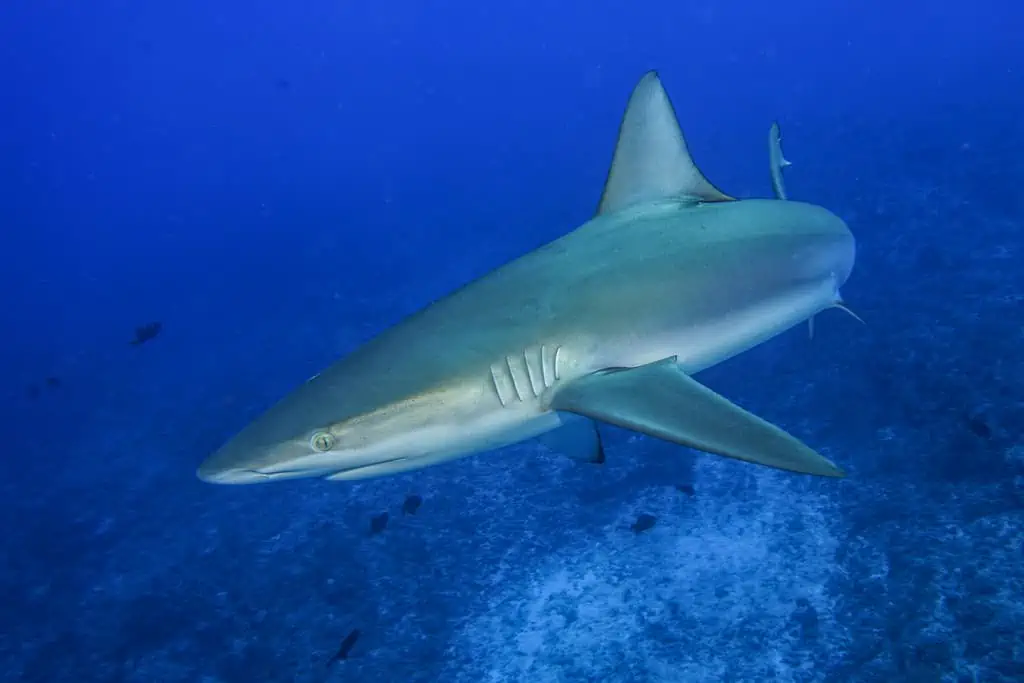
Because of their location, the Galápagos islands support a wide variety of marine wildlife. The Humboldt Current brings nutrient-rich water from Antarctica up the coast of South America. This makes the waters around the Galápagos Islands some of the most nutrient-rich in the world. It attracts Krill, Plankton, and small fish to the islands. In turn, this attracts the animals that feed off them.
There are a variety of species of sharks, whales, and rays that live near the Galápagos Islands. In total, roughly 33 different species of sharks can be found here. Depending on the season, roughly 24 different species of whales can be found in the island’s waters as well. Add to that the 19 different species of rays found in the Galápagos and you can see what this is a wildlife lover’s dream.
For those wondering what species you might see when you visit, you are in luck. I have compiled a list of some of the more frequently seen whales, sharks, and dolphins in my Galápagos Islands wildlife guide below.
Baleen Whales
There are two different classifications of whales found in the Galápagos, Baleen, and Toothed whales. Of the two, the Baleen whales include the larger of the whale species.
These whales feed by filtering water through their baleen, which is a bristly structure that is found in the whale’s mouth and is made up of the same substance that our hair and fingernails are made out of. They use this to filter small fish and krill from the water.
The Baleen whales found in the Galápagos Islands include the blue whale, Bryde’s whale, humpback whale, minke, and sei whales, among possible others.
Blue Whale |
June thru September |
 |
|
| These gentle giants can reach lengths of up to 85 to 100 feet and weigh as much as 200 tons, which makes them the largest animals on the planet and the heaviest animals to ever live. They migrate thru the Galápagos Islands every summer and are easily recognizable by their huge tails (that can be up to 25 feet in width), blueish-grey color, and small dorsal fins. | |
Bryde’s Whale |
Year-Round |
 |
|
| Bryde’s whales are the most commonly seen whales in the Galápagos Islands. These goliaths can easily be identified by their blue-grey backs, pointed dorsal fins, and narrow water spouts that reach an impressive 10-15 feet high. | |
Humpback Whale |
June thru September |
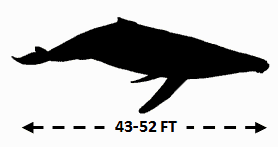 |
|
| Arguably the most fun of the whales you will find in the Galápagos Islands to watch, the Humpback whale is also one of the easiest to recognize. Their dark bluish-black bodies are often covered in barnacles and they frequently peak their heads above water to look around. If you are lucky, you will get to see one of these 45-ton creatures breach their whole bodies above the surface, which is spectacular to watch. | |
Minke Whale |
Year-Round |
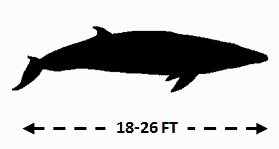 |
|
| The smallest of the baleen whales found in the Galápagos Islands, the Minke whale typically doesn’t weigh more than eight to ten tons. These whales can be recognized by their pointed head and snout, as well as the white patches on their flippers. They can be difficult to spot because their fin and fluke are only visible when they breach. | |
Sei Whale |
Year-Round |
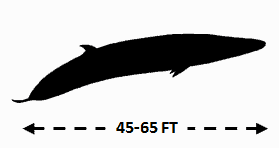 |
|
| The Sei whale is long and slender, with a dark grey body and tall, pointed dorsal fin. These features make it easy to distinguish from other whales you will find in the Galápagos Islands. Unlike many of the other whales I have highlighted, it feeds close to the surface and does not arch its back or show its flukes when it comes up for air. This can make it difficult to spot, even though they are usually found close to the surface. |
Toothed Whales
The other type of whale found in the Galápagos Islands is the Toothed whales. Unlike the Baleen whales, these whales have teeth and use them to hunt their food. Their food typically includes fish, squid, small porpoises, marine mammals like sea lions, and even other whales. The Toothed whales typically found in the Galápagos Islands include orcas, short-finned pilot whales, and sperm whales.
Orca (Killer Whale) | Year-Round |
 | |
| Orcas, which are also commonly called Killer Whales, are the largest members of the oceanic dolphin family. These large predators feed off of fish, sharks, rays, sea mammals, and even other whales. Resident Orcas are known to stay in one area for most of their lives, whereas transient Orcas are known to travel from one area to another. The Galápagos Islands have both resident and transient Orcas that can be spotted among the islands. The resident Orcas are typically fish eaters and tend to be more playful and curious about boats, whereas the transient Orcas are marine mammal eaters and are not as likely to approach boats. | |
Short-Finned Pilot Whale | Year-Round |
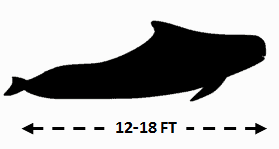 | |
| Part of the dolphin family, the Short-finned pilot whales are typically dark grey or black with a grey or white cape. These whales can also be distinguished by their sharply pointed flukes with a distinct notch in the middle. The whales feed on fish, squid, and octopus, which they need to dive deep to hunt. They are known to float motionless at the surface of the water and then raise their tail flukes high out of the water just before diving. As residents of the Galápagos Islands, they can be seen year-round around the islands. | |
Sperm Whale | Year-Round |
 | |
| The Sperm Whale is the largest of the toothed whales and the largest toothed animal on the planet. They can be regularly seen around the Galápagos Islands. They are named after the milky-white, waxy substance that can be found around its head. The whales feed primarily on squid, which they must dive deep to hunt. They can easily be identified by their large square heads, but because they are such deep divers they are rarely seen up close. |
Dolphins
Bottlenose Dolphin | Year-Round |
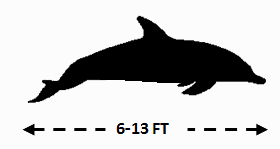 | |
| The Bottlenose dolphin is the most commonly seen dolphin or whale in the Galápagos Islands. They will often travel in large pods and can be often seen playing in the bow waves of ships and yachts in the area. They can easily be identified by their dark grey or black back-side with a pale under-belly, as well as their short beak and curved dorsal fin. | |
Common Dolphin | Year-Round |
 | |
| The Common Dolphin looks very much like its close relative the Bottlenose Dolphin, but they are smaller, have a longer beak, straighter dorsal fin, and a dark stripe that runs from their dorsal fin to their chin. They are commonly spotted in the Galápagos Islands but are not as common as the Bottlenose Dolphin. | |
Striped Dolphin | Year-Round |
 | |
| These stunningly beautiful creatures are seen far less likely than the Bottlenose or Common Dolphins because they rarely play in the bow waves of boats, but lucky visitors to the Galápagos can easily identify them by their curved dorsal fins and beautiful stripped color pattern on their bodies. |
Sharks
Whale Shark | June thru December |
 | |
| These gentle and beautiful creatures are one of the main draws for scuba divers who travel to the Galápagos Islands. These sharks, which are the largest sharks and thus the largest fish on the planet, congregate around Darwin and Wolf Islands in the far North of the Galápagos to feed on a large amount of Plankton in the area. They can often be seen feeding near the surface of the water, but the real draw is getting into the water and scuba diving with these beautiful creatures. | |
Galápagos Shark | Year-Round |
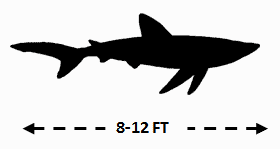 | |
| Despite its name, this migratory shark isn’t just found in the Galápagos Islands but can be found all over the world. They primarily feed off of fish, but in the Galápagos Islands, they also feed on Galápagos Sea Lions and Galápagos Fur Seals. They closely resemble reef sharks so they can be difficult to identify in the water. Although these sharks can be found in many locations around the Galápagos, in my opinion, the best place to see these amazing creatures when diving is near Darwin’s Arch off of Darwin Island in the far North of the Galápagos Islands. | |
Scalloped Hammerhead | June thru November |
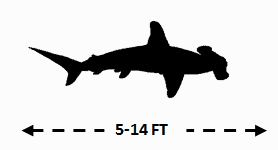 | |
| While Smooth Hammerhead and Great Hammerhead species can also be found around the Galápagos Islands, they are found in far fewer numbers than the Scalloped Hammerheads that travel in mass to the islands each June. These incredible sharks are easily identified by their unique and interesting head. Many scuba divers travel to the Galápagos Islands each year to see the large schools of these sharks feeding off the islands. Sometimes there will be so many sharks swimming in the area that the sunlight will be blacked out if you are swimming below them. In my opinion, the best place in the Galápagos Islands to swim with Hammerhead sharks is near Gordon Rocks off of Santa Cruz Island. This submerged volcano attracts very large schools of Hammerhead sharks on a regular basis. | |
White-Tipped Reef Shark | Year-Round |
 | |
| The White-Tipped Reef Shark is a common shark species that you will find around the Galápagos Islands. They are easily distinguished by the white tips on their fins. These small sharks primarily feed off of small fish, octopus, spiny lobsters, and small crabs. They can often be spotted in resting in shallow channels with warm water, which is why the Galápagos Islands is such a great location to see these sharks. The Galápagos has many small, shallow channels and ledges in the volcanic rock that are perfect resting spots for White-Tipped Reef Sharks. In my opinion, the best location to snorkel with them is at Tintoreras off of Isabela Island. | |
Grey and Black-Tipped Reef Shark | Year-Round |
 | |
| Grey and Black-Tipped Reef Sharks are another common shark species that are found in the reefs around the Galápagos Islands. These sharks primarily feed on a wide range of fish, including sardines, herring, mullet, jacks, and Spanish mackerel. Like the White-Tipped Reef Sharks, they prefer warm, shallow waters as opposed to the deep, open waters of the ocean. This means that is quite common to see these sharks in locations such as Tintoreras and Los Tuneles off of Isabela Island, Devil’s Crown off of Floreana Island, and Kicker Rock off of San Cristobal Island. |
Galápagos Green Sea Turtles
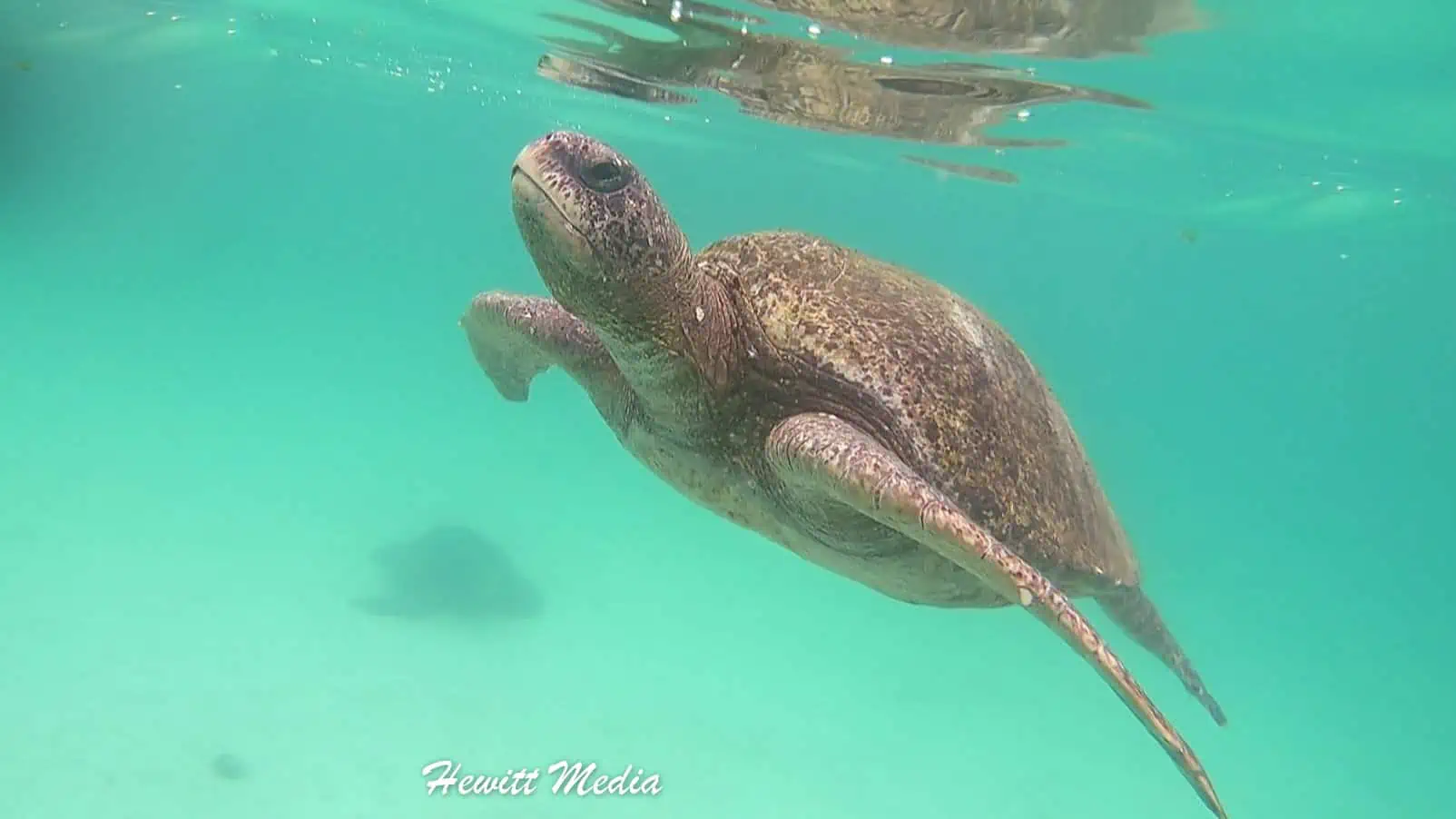
Arguably one of the favorite attractions of snorkelers who visit the Galápagos Islands, Green Sea Turtles are frequently seen in the shallow waters just off of the Galápagos.
These magnificent animals can be seen around the islands year-round, but between December and March, the pregnant females come to shore to lay their eggs at night.
In my opinion, the best places to snorkel with Green Sea Turtles include Tintoreras and Tagus Cove off of Isabela Island, Punta Espinosa off of Fernandina Island, and Kicker Rock off of San Cristobal Island.
Galápagos Finches (Darwin’s Finches)
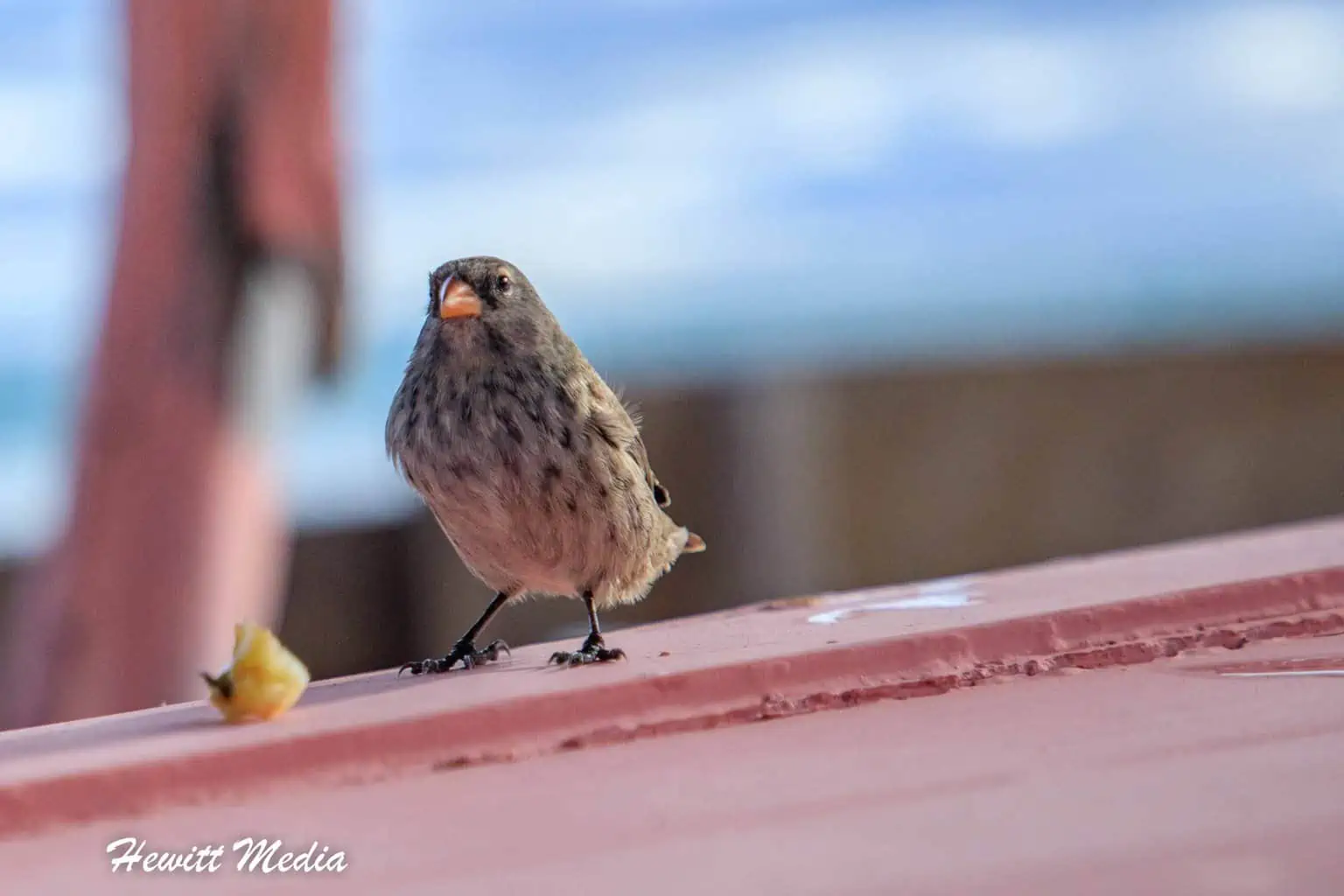
No other animals in the Galápagos Islands have had as significant a role in the history of the islands as the Darwin Finches. These small birds, which are actually roughly 15 different species of birds, were used by Charles Darwin to prove his theory of evolution during his Second Voyage of the Beagle. To better understand the evolution of these birds, please check out the illustration I have provided in my Galápagos Islands wildlife guide below.

If you take a look at the chart above, you can see how the different finches that are found in the Galápagos Islands have evolved to fit different niches on the islands. Some of the finches have evolved to live on the ground, while some have evolved to live in the trees.
Some of the finches almost exclusively eat fruit, while some of the finches eat insects, cactus, or seeds. I have included a description of some of the more common finches that you will find in the Galápagos Islands in my Galápagos Islands wildlife guide below.
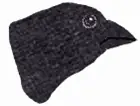 | 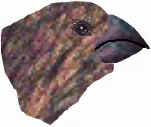 | |
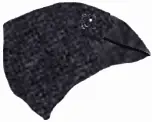 |  | |
 |  | |
 | 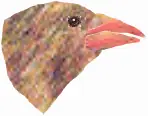 | |
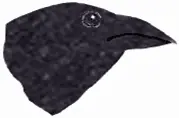 |  |
Galápagos Brown Pelican
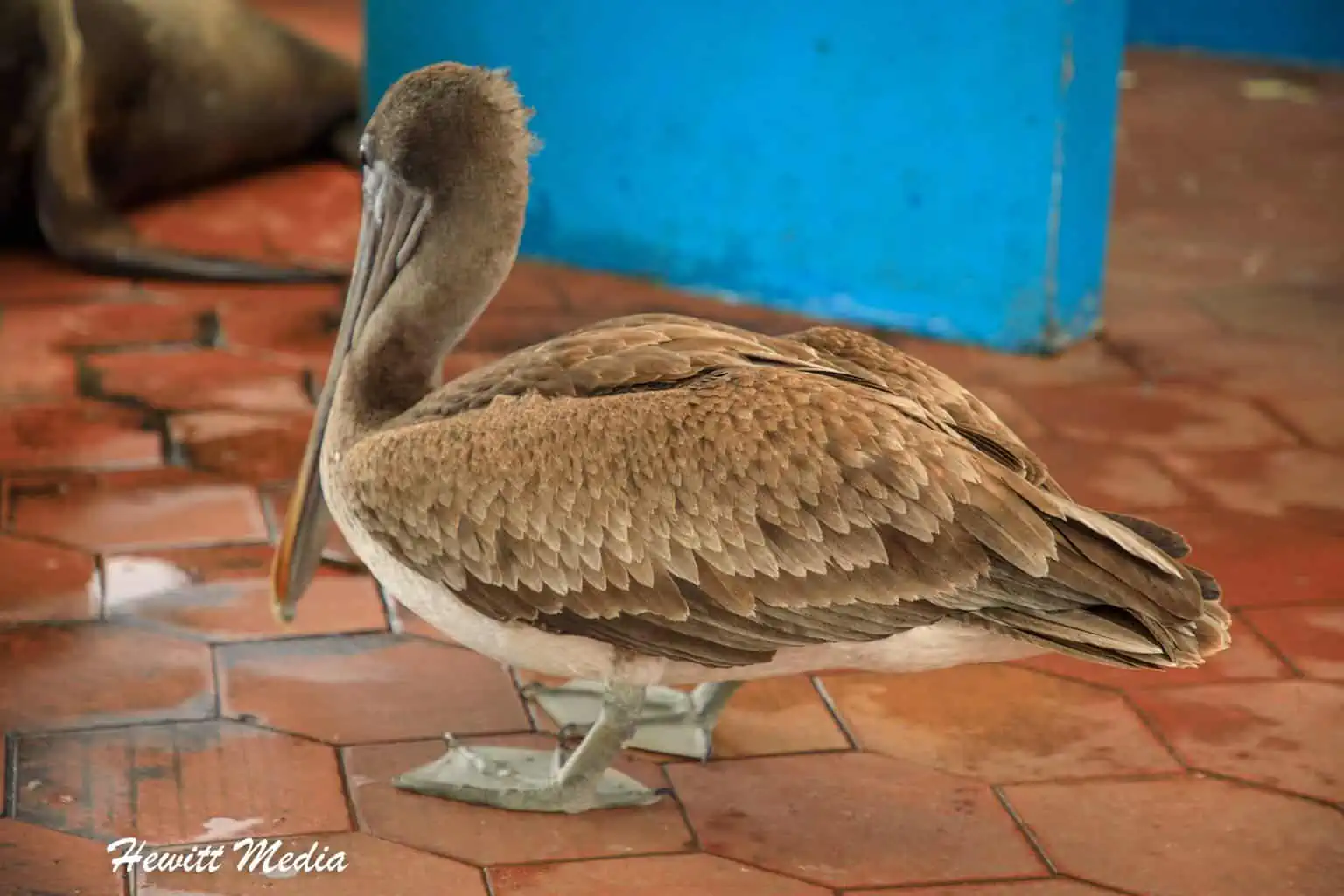
The Galápagos Brown Pelican is an endemic species to the Galápagos Islands, which means that this species of the pelican is unique to the Galápagos. These large birds can be found throughout the Galápagos Islands and can usually be found around the water. They hunt for fish by flying low over the water to spot their prey and then plunge into the water to catch them.
You may also spot these birds anywhere that humans are fishing or cleaning fish. As you can see in the picture of a Galápagos Brown Penguin I included in my Galápagos Islands wildlife guide above, they are typically waiting for fish scraps at the fish market on Santa Cruz Island.
American Flamingo
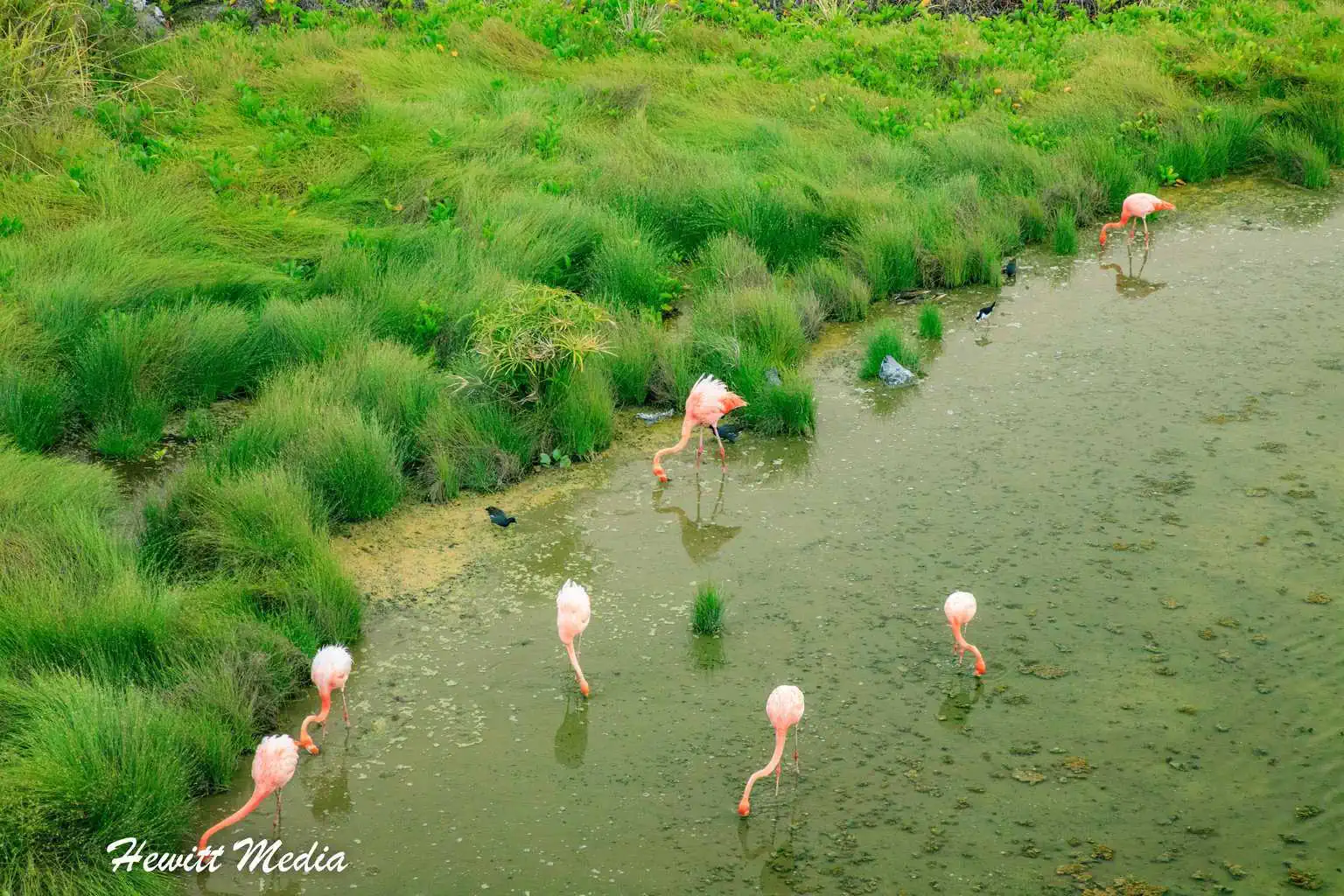
The American Flamingo is not an endemic species to the Galápagos, which means it did not originate in the Galápagos Islands and it is not uniquely found in the Galápagos. Instead, it is thought that these birds flew here from Central America and became trapped.
American Flamingos can typically be found in shallow, brackish pools of water where they feed on brine shrimp or Artemia. Because they require brackish water to feed, they are only found in limited locations in the Galápagos Islands. The best islands to view in which to view them include Isabela, Floreana, Santa Cruz, and sometimes San Cristobal.
Blue Footed Booby
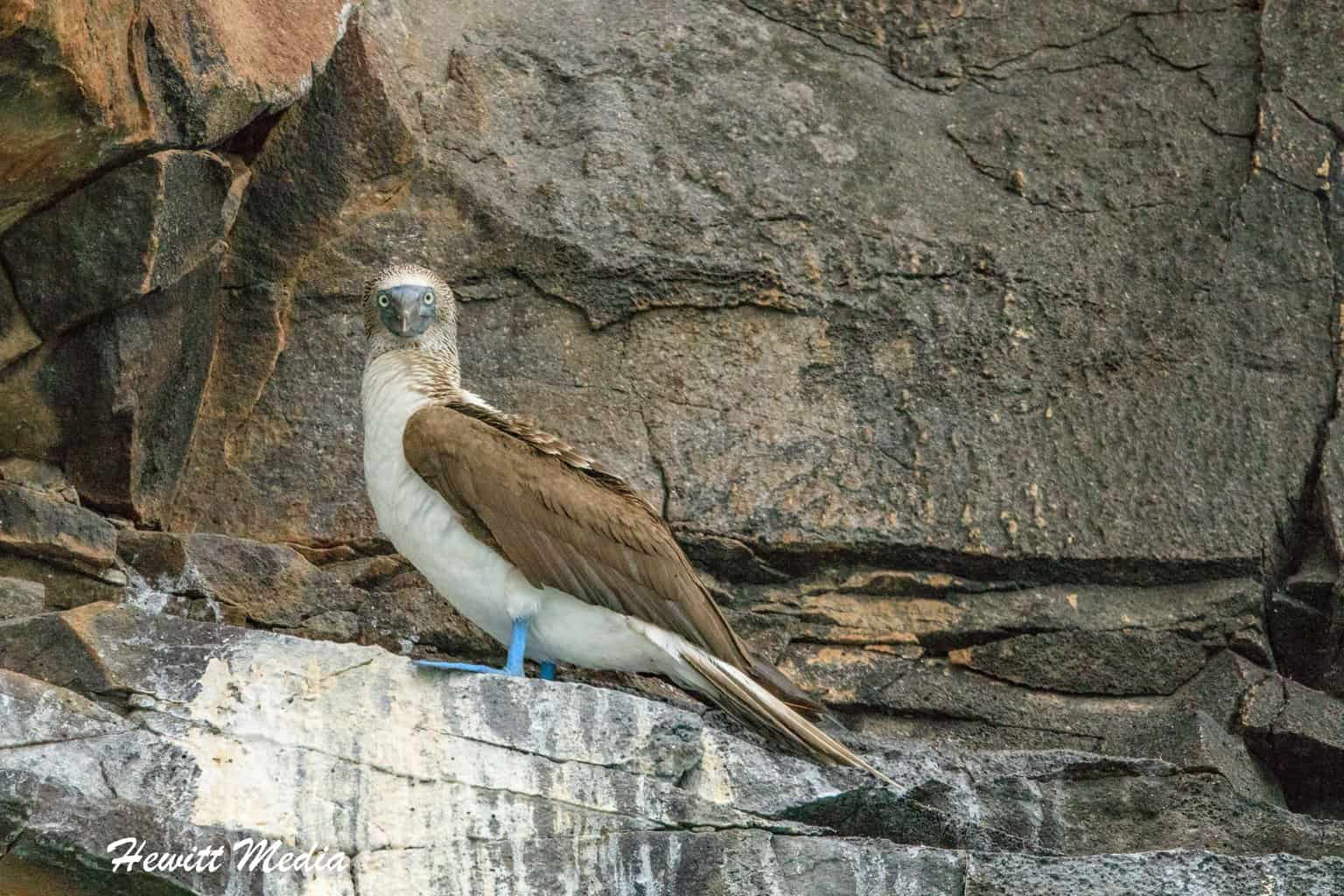
The name Blue-footed Booby is derived from the Spanish word “bobo”, which means “foolish” or “clown”. These large birds were given this name because of their clumsiness while on land. Even though they may not be the most graceful animals while walking, in the air they are anything but clumsy.
In fact, these birds are widely considered to be some of the most graceful hunters of all the birds you will find in the Galápagos Islands. They dive into the water to catch fish from as high as 20 feet above the water at speeds over 60 miles per hour. They can be found throughout the islands but are most prevalent on the Eastern shores of the islands.
The best place to see sea-bird activity, including the famous Blue-footed Boobies in action, is on the coast of North Seymour Island. The Blue-footed Boobies spend most of their time out at sea fishing, so one of the best times to see them is during their nesting season, between June and August when the birds are at shore more frequently.
Red Footed Booby
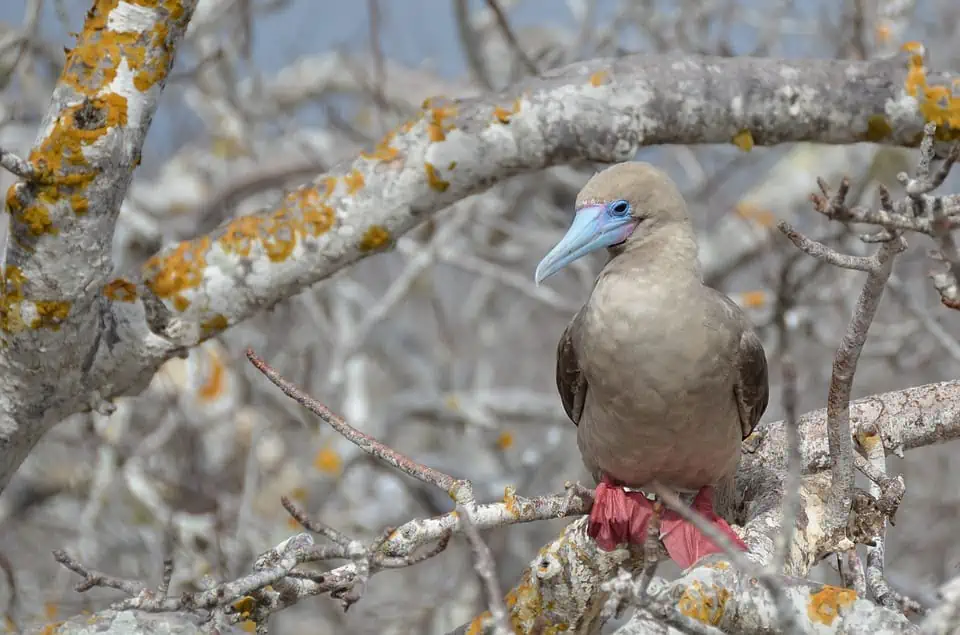
Like their blue-footed cousins, the Red-footed Boobies are not the most graceful creatures while on land but are graceful flyers and fishermen. These birds can be found throughout the Galápagos Islands, but the best place to see them is on Genovesa Island, where the largest colony of Red-footed Boobies is known to live.
If you are lucky, you may get to see the Red-footed Boobies do their mating courtship when you visit. Like the Blue-footed Boobies, the Red-footed Boobies do a unique mating dance, where the males throw back their heads to expose their colorful blue throats. This dance is known as “sky pointing”, as they are pointing their beaks to the sky as if to point.
Great Blue Heron
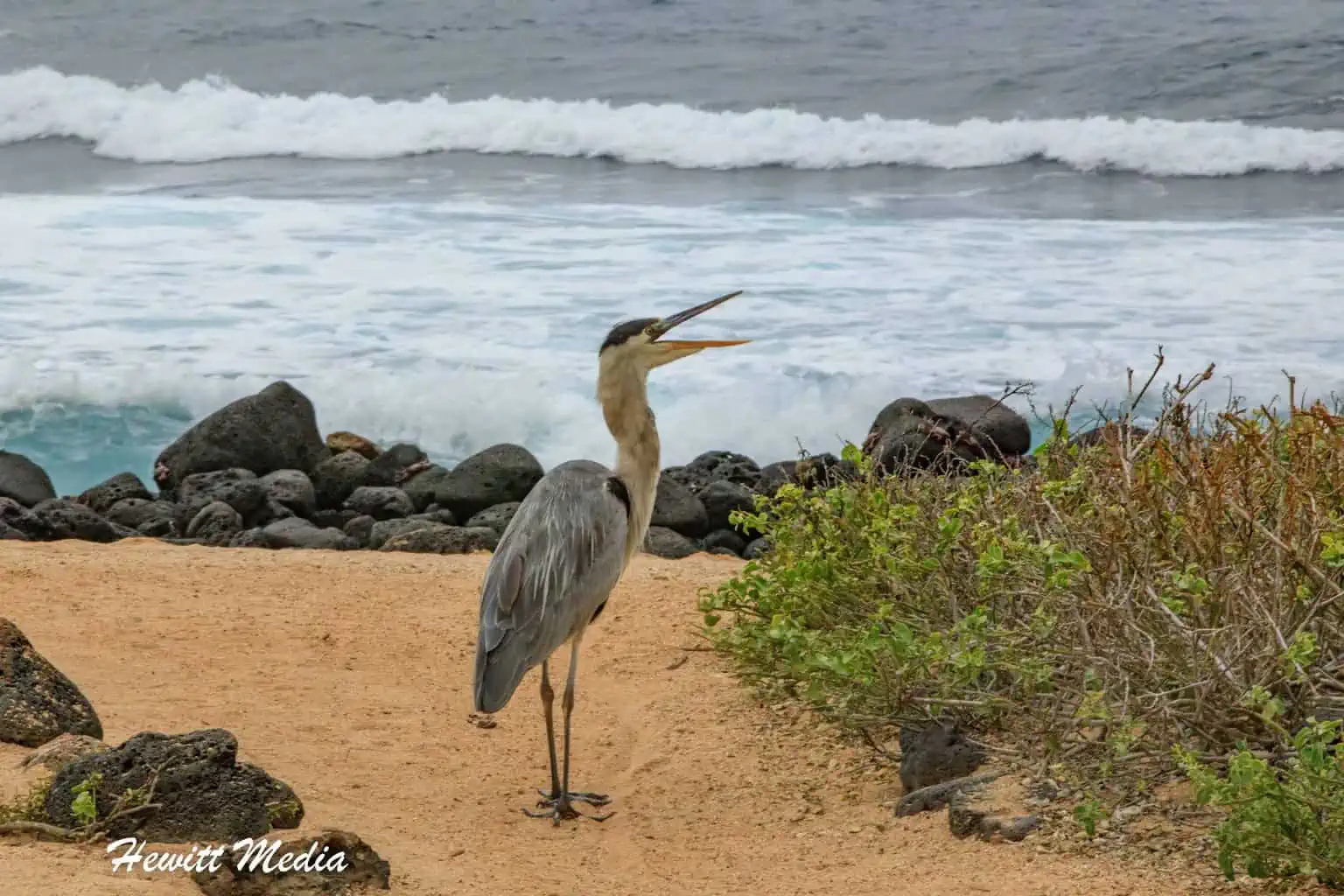
There are roughly 21 different species of water birds that live in the Galápagos Islands, and the Great Blue Heron is one of the prettier ones.
These birds, who live in the coastal region of the Galápagos Islands, mostly feed on fish but are also known to eat crabs, rodents, insects, lizards, and other birds. They prefer to fish in shallow waters that they can wade in, and primarily hunt during the hours around dawn and dusk.
The Great Blue Herons can easily be identified by their long necks and legs, lack of webbing on their feet, and their long dagger-like bills. Be careful not to misidentify one of the smaller, white herons (often referred to as egrets) as a Great Blue Heron, as many of their other body features are similar. The best places to spot the Great Blue Heron include coastal bays on San Cristobal Island, Santiago Island, and Santa Cruz Island.
Waved Albatross
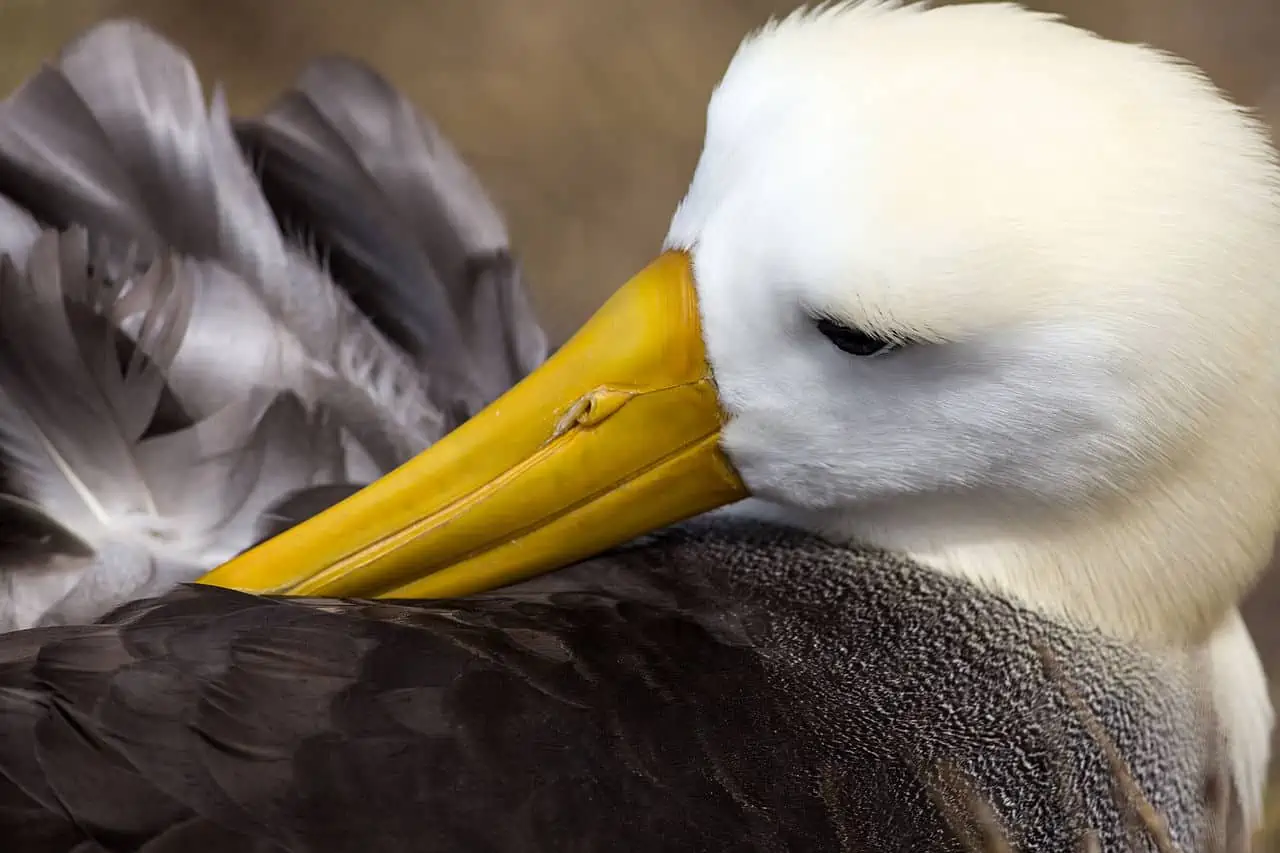
The Waved Albatross is one of the most unique and rare birds you will find in the Galápagos Islands. If you want to catch a glimpse of one of these amazing birds, your best bet is to visit Española Island around April, as that is the world’s only breeding site for the Waved Albatross and they begin showing up on the island at around that time.
These expert fish hunters can have a wingspan of up to 8 feet (or 2.5 meters) in length, which makes them the largest bird in the Galápagos Islands. They get their name from the wave-like pattern that forms on their wings as adults. They are mainly chestnut brown, with a white head and underwing.
When they aren’t breeding, these amazing birds can be found fishing in the Eastern waters of the Galápagos Islands and as far East as mainland South America. The only time these birds aren’t spotted on land is between January and March. For the lucky visitors who visit Española Island in June, you might be able to catch a glimpse of the eggs hatching and the newborn Waved Albatross taking their first leaps from the ocean cliffs.
Sally Lightfoot Crabs
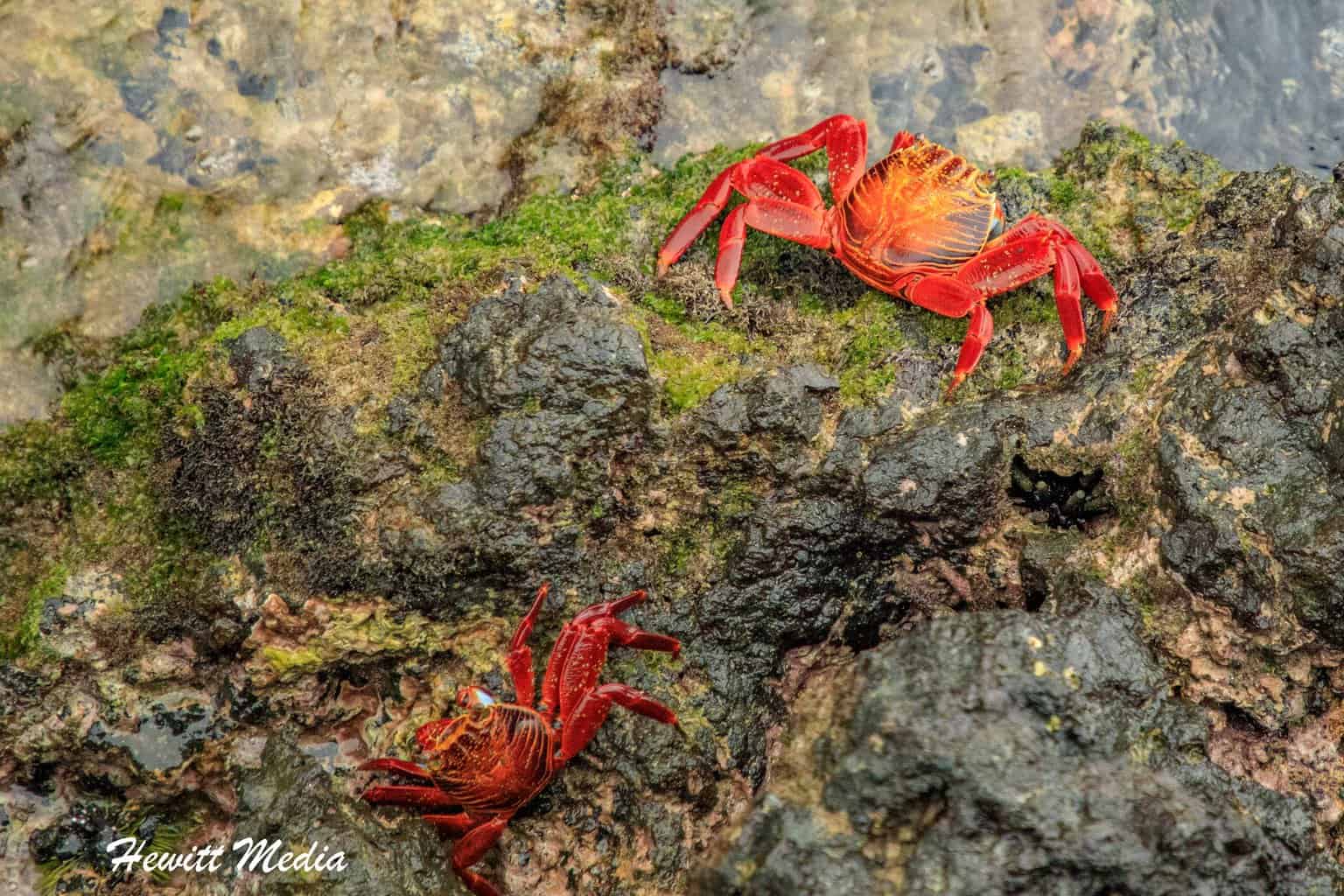
If you walk along the shores of the Galápagos Islands, and especially the areas that are strewn with volcanic rock, you will notice an abundance of brightly colored crabs scurrying about.
These cute little creatures are Sally Lightfoot crabs, and they can be found all around the Galápagos Islands and on the coasts of Central and South America.
The Sally Lightfoot crabs aren’t always so colorful. When they are born, the crabs are actually anything but colorful, and for good reason. The crabs are born black, which makes it easier for the crabs to blend into the black volcanic rock and avoid predators.
As they grow, they shed their black shell in favor of the bright, colorful shells that we are used to seeing in photographs of the Galápagos. Many of the pictures you see are of red crabs, but the crabs can actually have intense blue-colored shells as well.
Flightless Cormorant
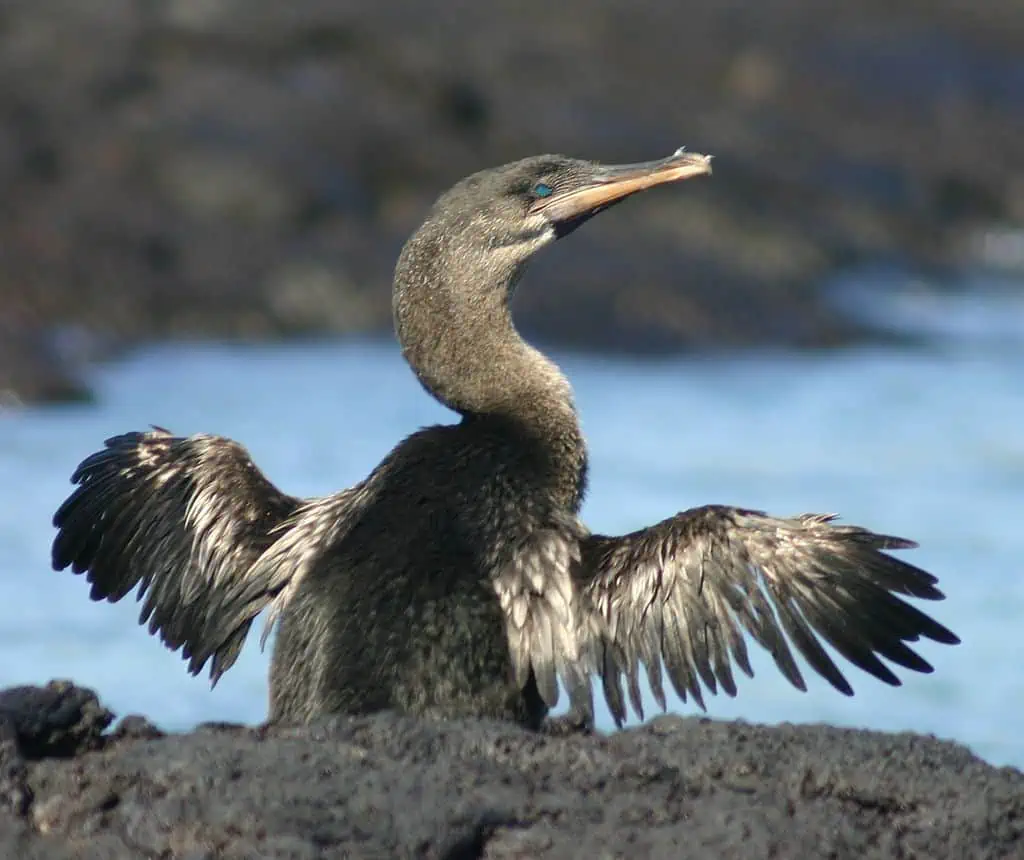
As their name suggests, the Galápagos Flightless Cormorant, which is an endemic species to the Galápagos Islands, is unable to fly. Because of this, these birds are confined to the rocky, volcanic shorelines of Fernandina and Isabela Islands.
The loss of their ability to fly was an evolutionary adaptation, as flying became increasingly unnecessary for these birds who are excellent swimmers and dive to catch their meals. Their webbed feet and strong legs allow them to dive to the ocean floor to catch octopus and small fish.
In addition to their stunted wings, these amazing birds can also be easily identified by their blacked feathered tops, light brown underbelly, and piercing turquoise eyes. If you are out on a snorkeling expedition and are lucky, you might be able to catch a glimpse of these birds diving for food while in the water. It is a really amazing thing to see in person.
Magnificent Frigatebird
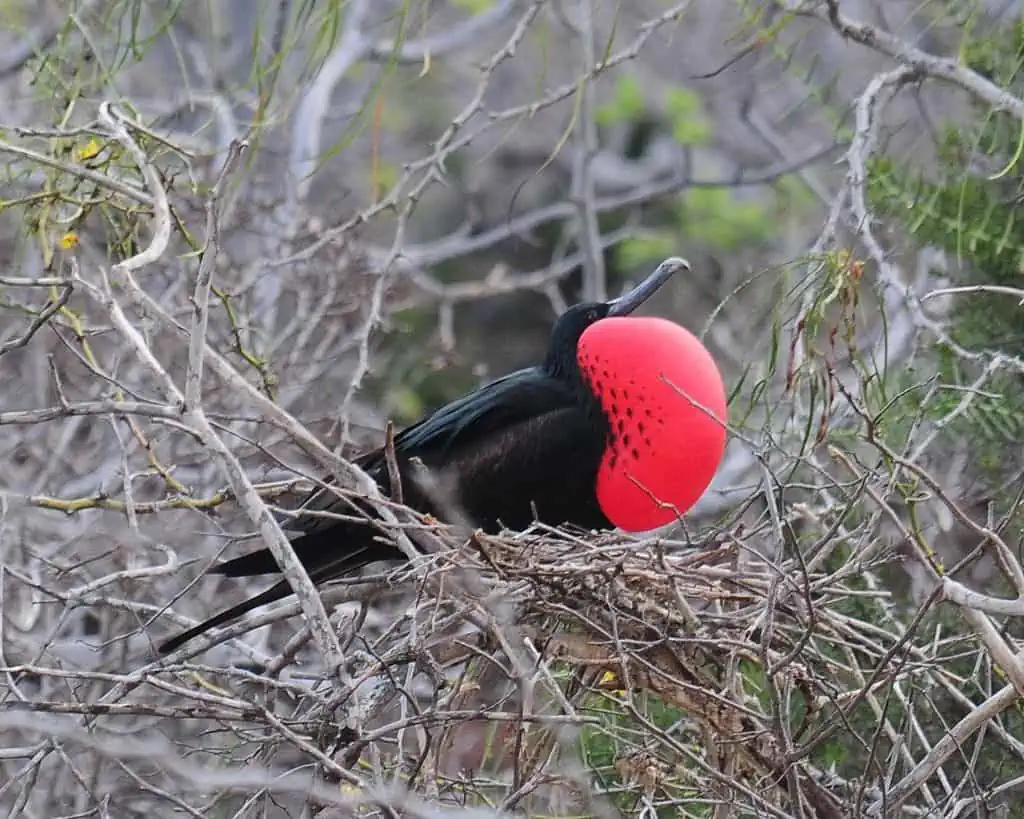
One of the most easily recognizable birds in the Galápagos Islands, the Magnificent Frigatebird has been given many different nicknames over the years. Charles Darwin famously called the birds the “condor of the oceans”, as the birds use their long wingspan to glide on thermals for days at a time. In fact, these birds have the longest wingspan-to-body ratio in the world, which is quite remarkable.
Sailors used to also call the Magnificent Frigatebirds “pirate birds” because they were famous for stealing food from other birds. The Magnificent Frigatebirds will chase other birds and then grab their tail feathers, forcing the birds to regurgitate their food. Hence the nickname associating them with pirates.
These exceptional birds can easily be identified by their colorings. The male birds are all black except for a red throat pouch, which they inflate during mating season to attract the females.
The female birds are mostly black with a white breast and shoulders, as well as a blue eye ring. They can be spotted throughout the Galápagos Islands, but the main breeding colonies are located on North Seymour, Floreana, San Cristobal, and Genovesa Islands.
Charles Darwin Research Center
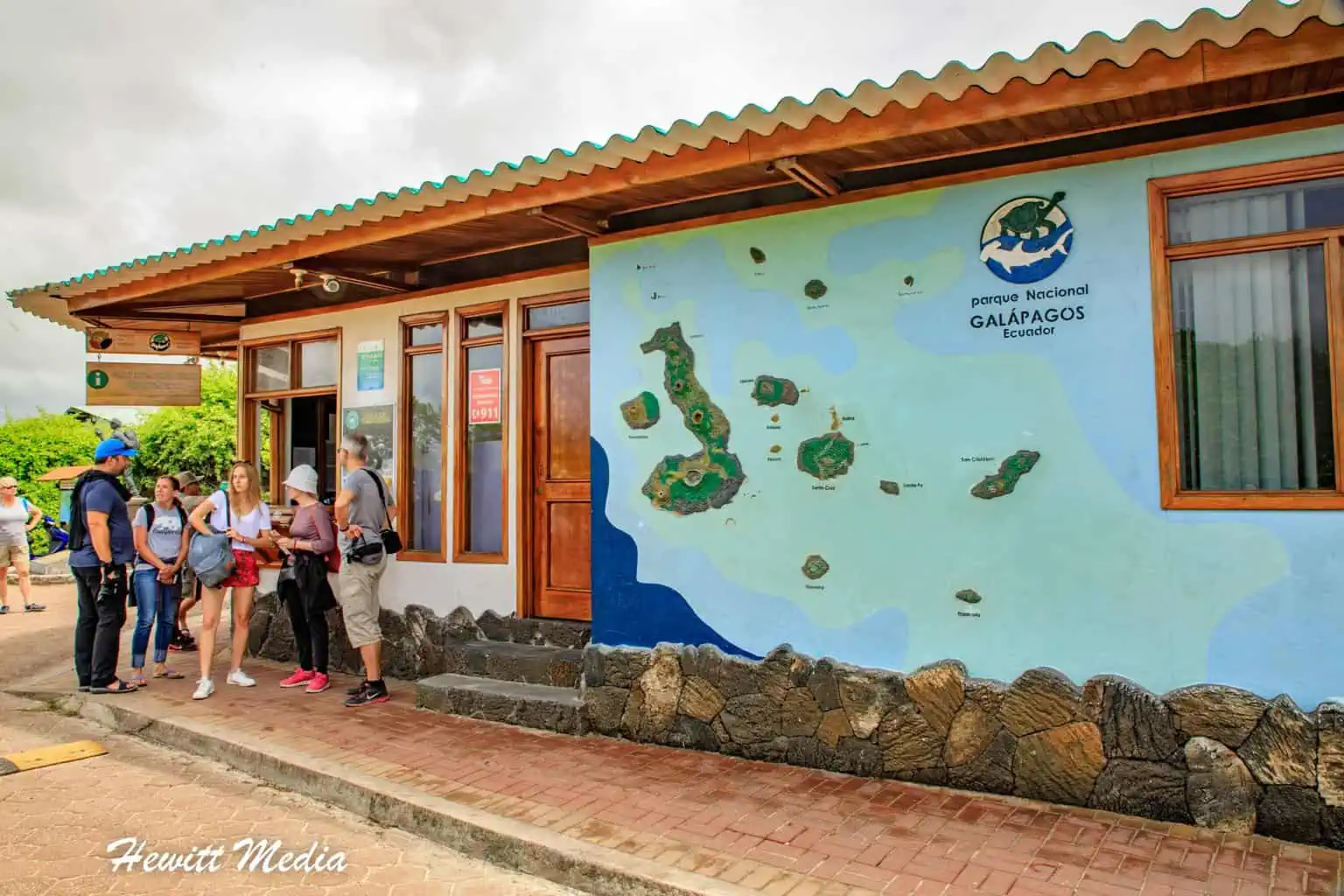
If you are interested in learning more about the wildlife of the Galápagos Islands, I would strongly recommend that you make a stop at the Charles Darwin Research Station.
Located on Santa Cruz Island, within walking distance of Puerto Ayora, the Charles Darwin Research Station is used by scientists to study the Galápagos Islands and advise on how to best preserve this unique and delicate ecosystem.
It is open to visitors, free of charge, and allows you to get a first-hand look at the conservation efforts in the Galápagos. For more information on where the research station is located, please refer to the map I have included in my Galápagos Islands wildlife guide below.

One of the big draws to visiting the Charles Darwin Research Station is to get a first-hand look at their Galápagos Giant Tortoise Breeding Center. Here, you get to see the efforts underway to breed these amazing animals and keep the population of each distinct species of giant tortoise healthy.
They mark each tortoise with a colored dot on its back that represents which island it was taken from so that they know which island to return the tortoise to when it grows to a sufficient age to be released.
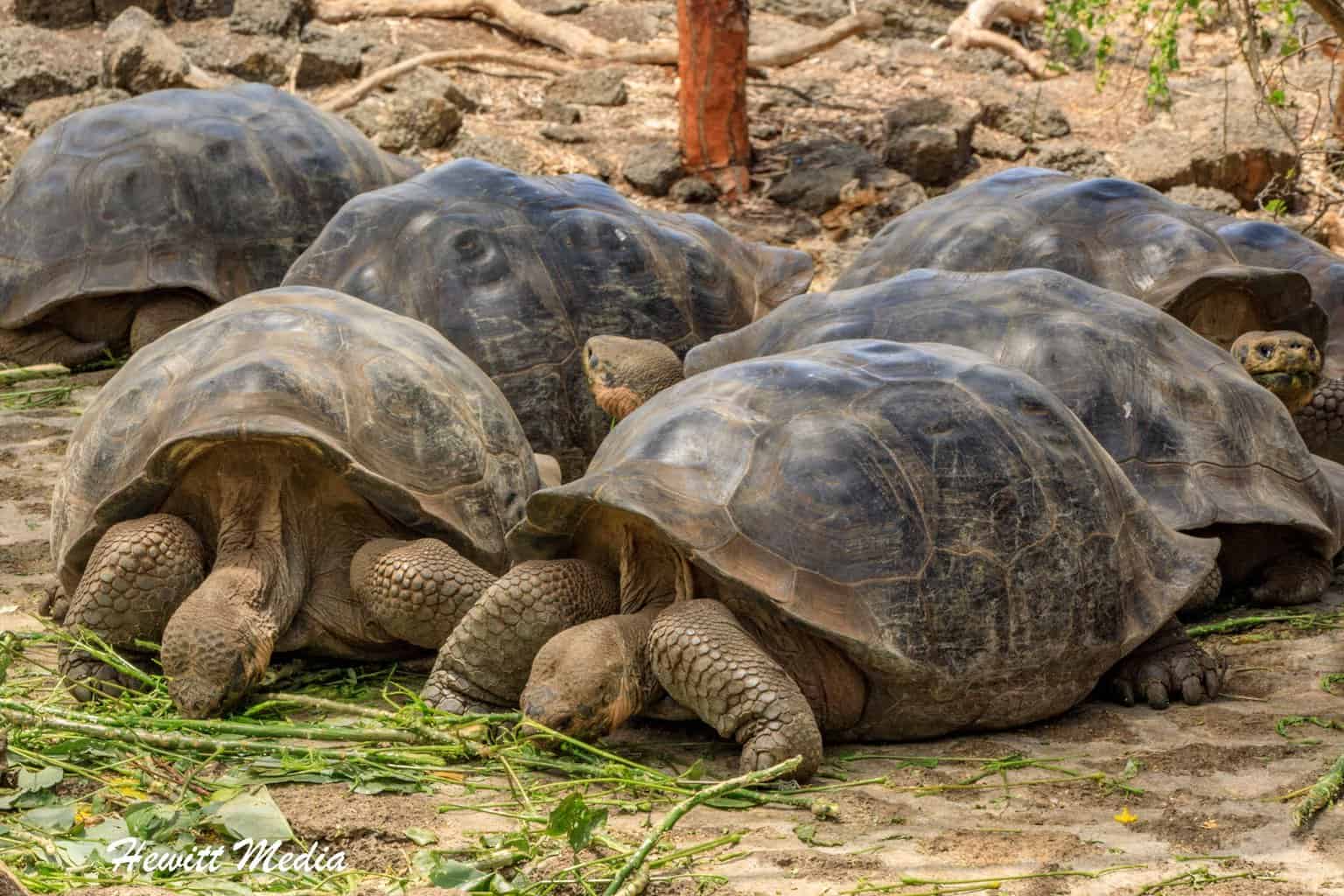
The Charles Darwin Research Center also has a very unique exhibition on marine life. At the Van Straelen Interpretation Center, visitors can learn about conservation efforts underway to protect the whales, sharks, and other marine wildlife that call the waters around the Galápagos Islands their home. The Marine World Exhibit includes artifacts and information panels that teach visitors about the fragile marine ecosystem of the Galápagos and inform visitors on how humans and the marine wildlife of the Galápagos can successfully co-exist.
Galápagos Islands Wildlife Photo Gallery
The Galápagos Islands are full of some very unique and amazing wildlife. For photographers, there is a wealth of opportunities to capture this amazing wildlife in photographs when you visit. I have included some of the wildlife images that I was able to capture during my visit to the islands in my Galápagos Islands wildlife guide below.
If you would like to see more of my travel photography, I would also encourage you to give me a follow on Instagram. Putting this blog together to pass on my free guides, itineraries, and travel photography tips is a lot of work and your support in the form of a follow-on Instagram would be so very much appreciated!
FOLLOW ME!
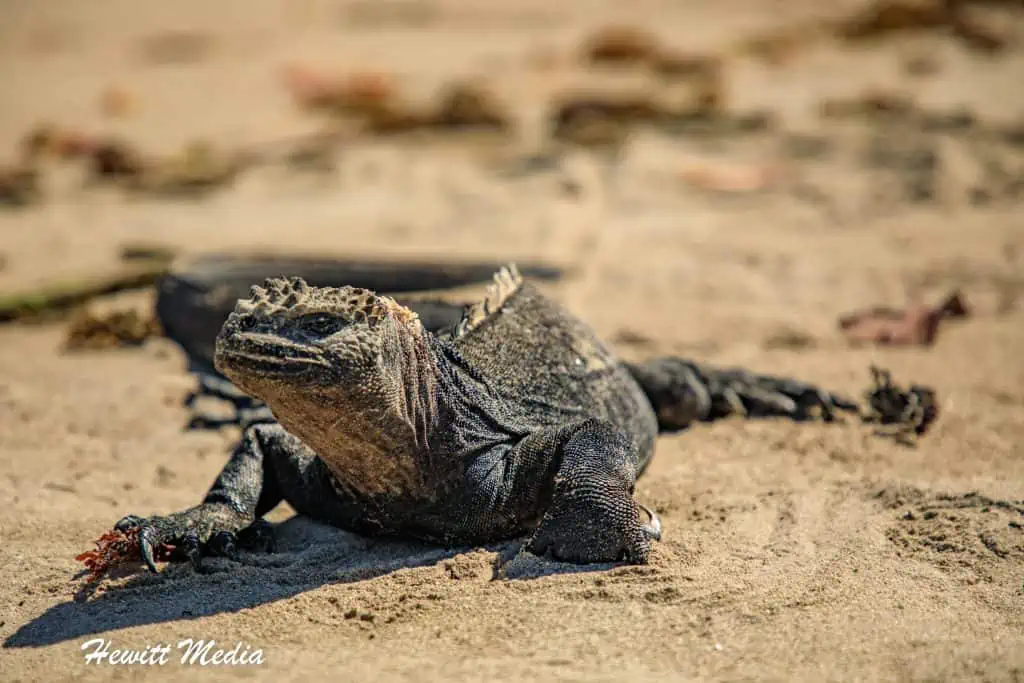
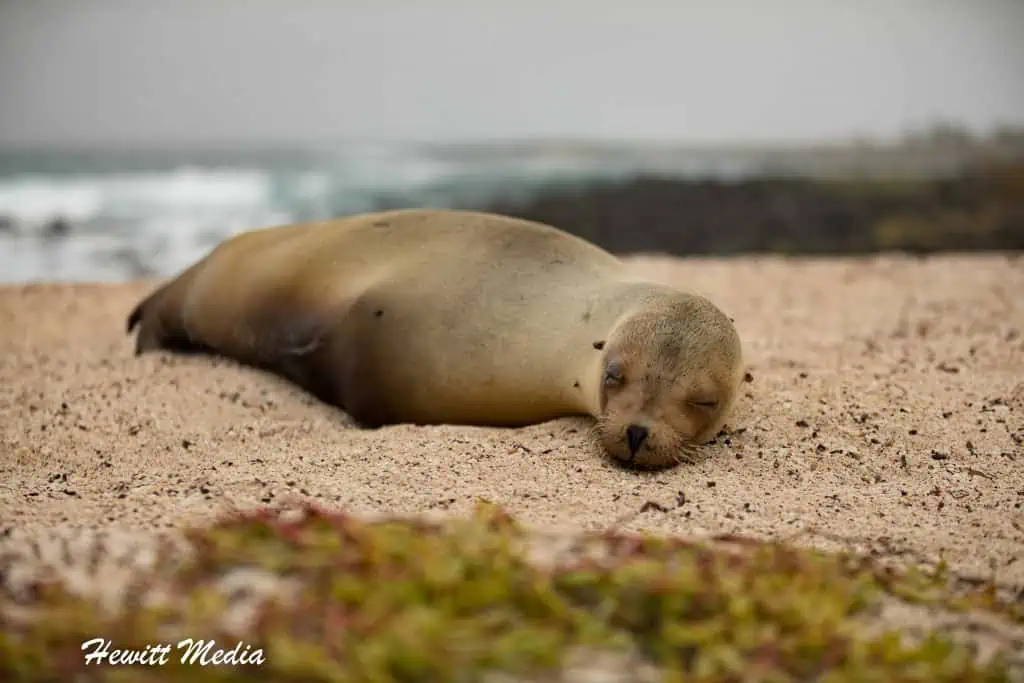
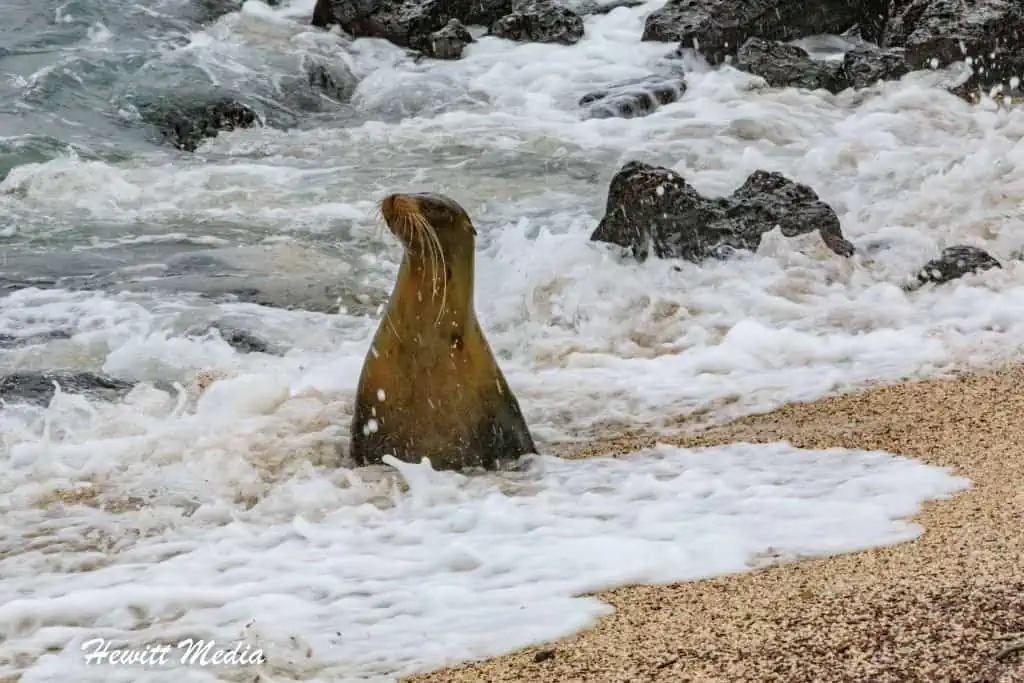
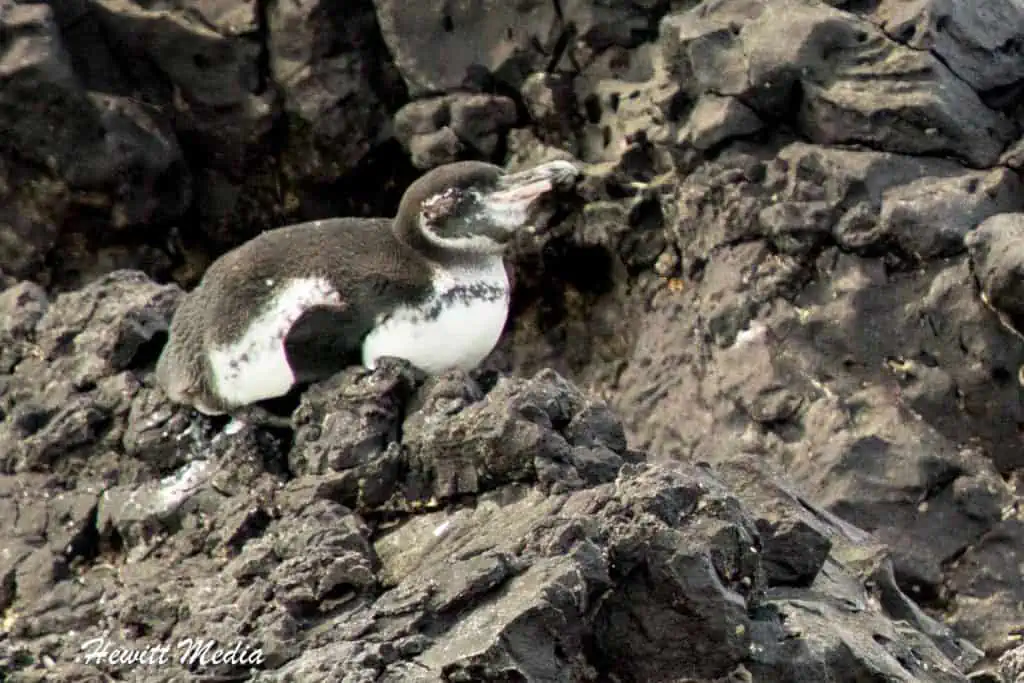
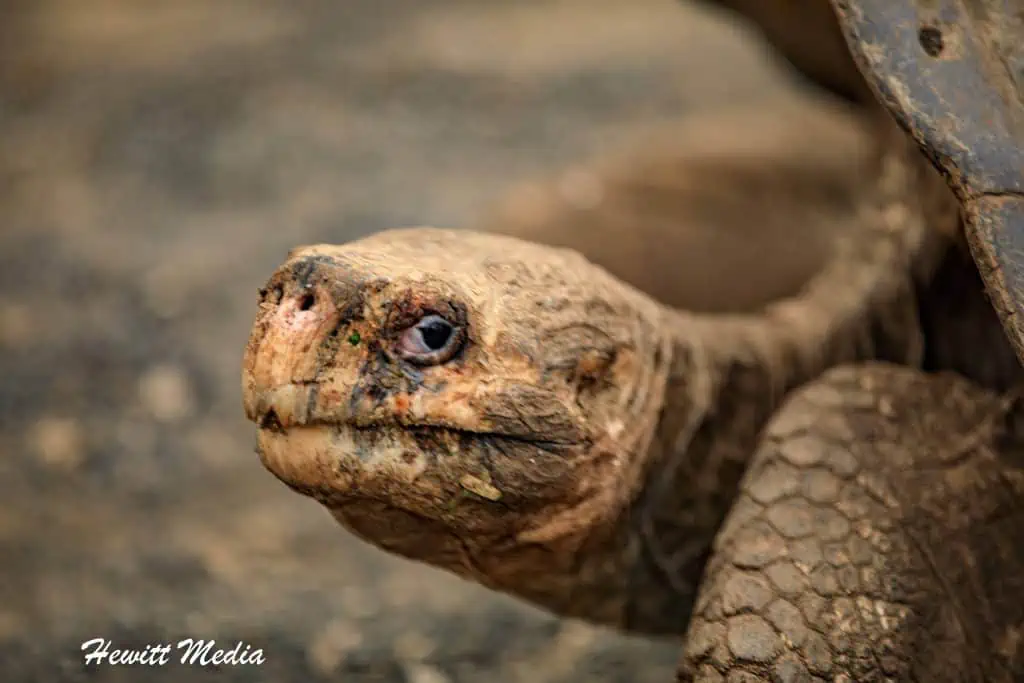
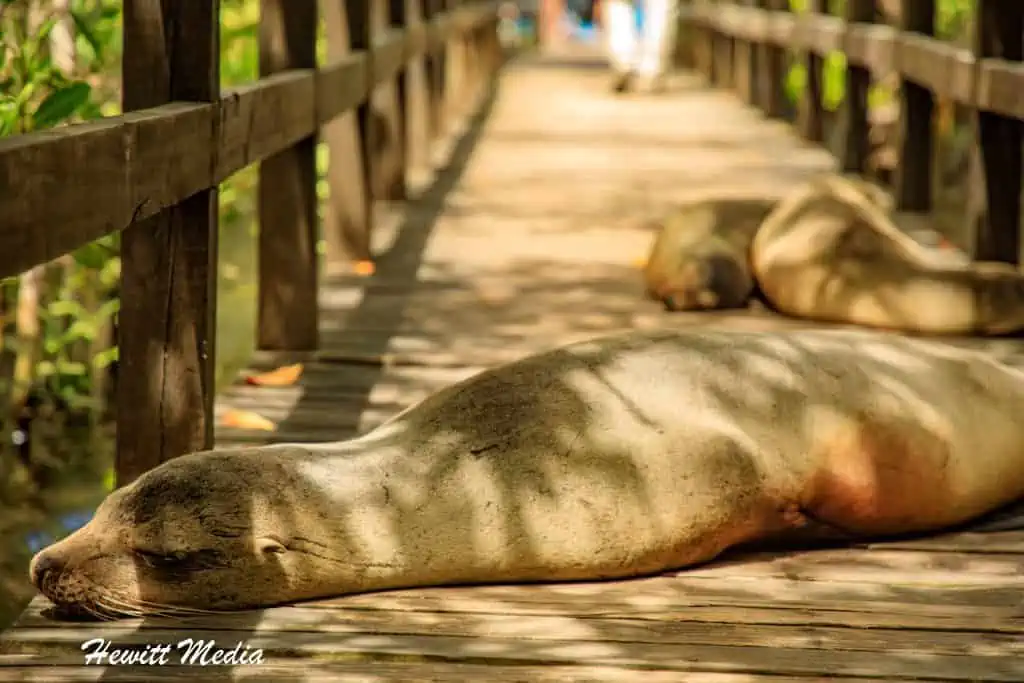
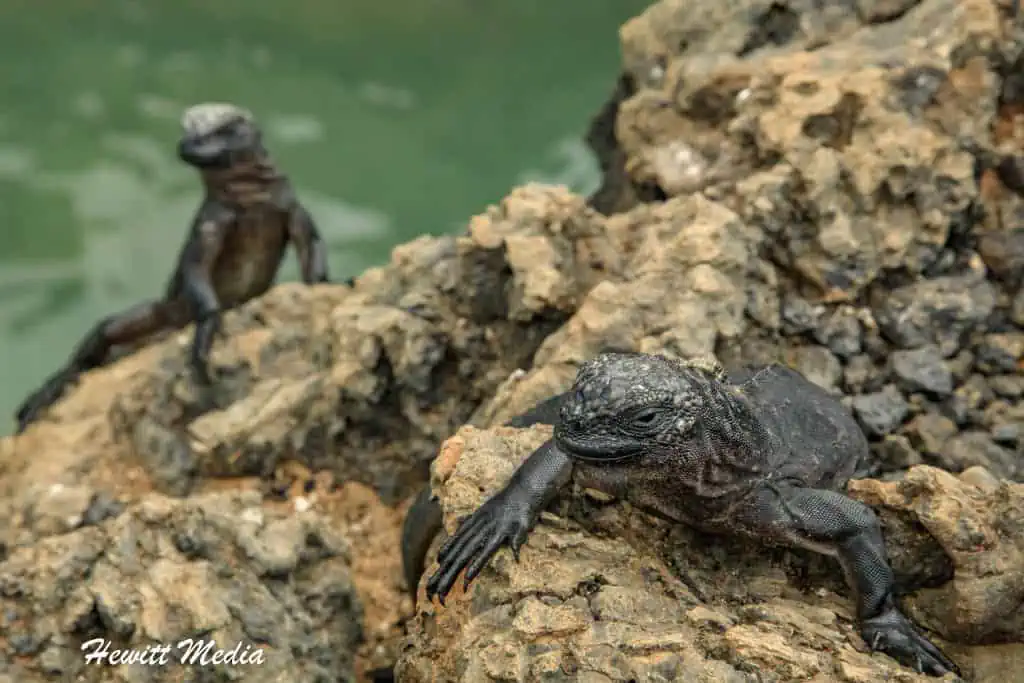
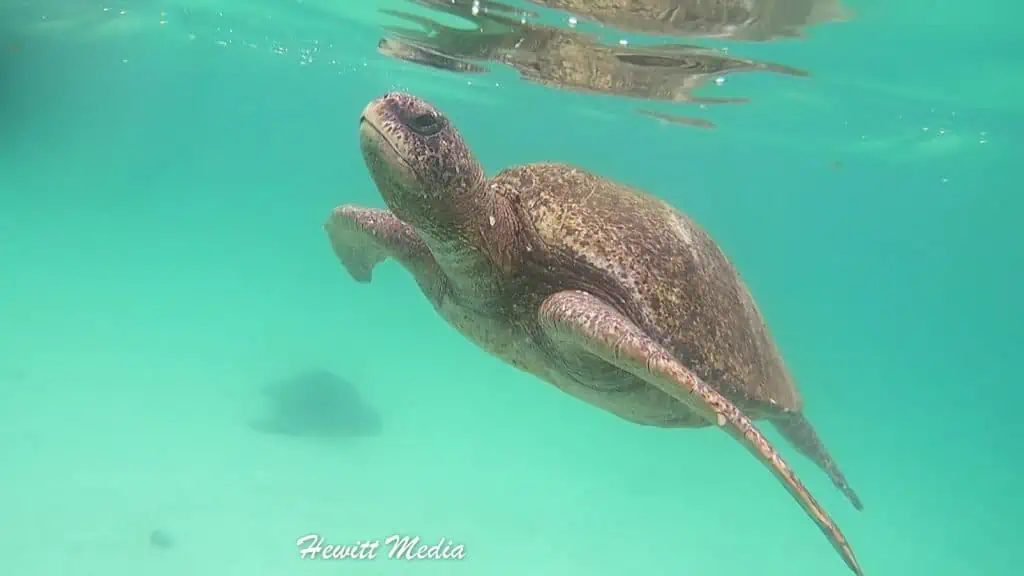
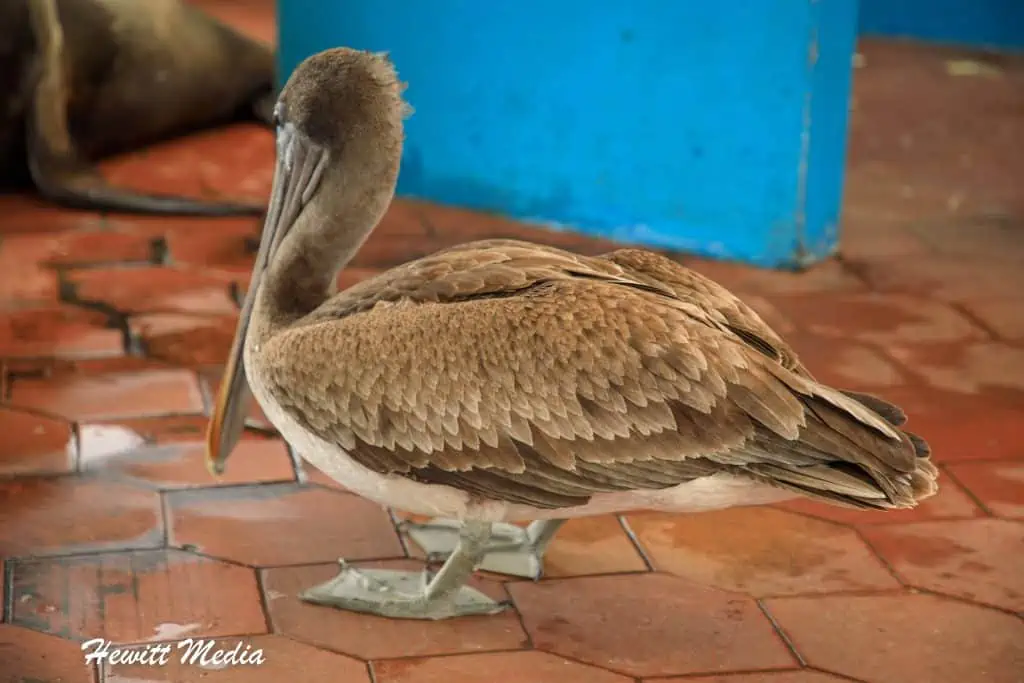
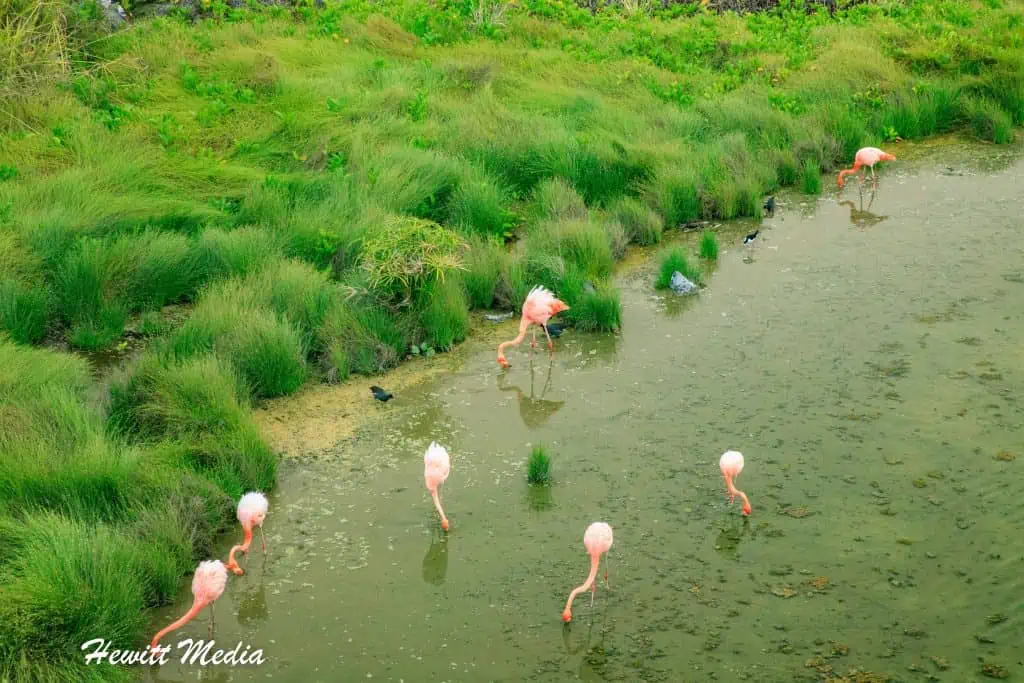

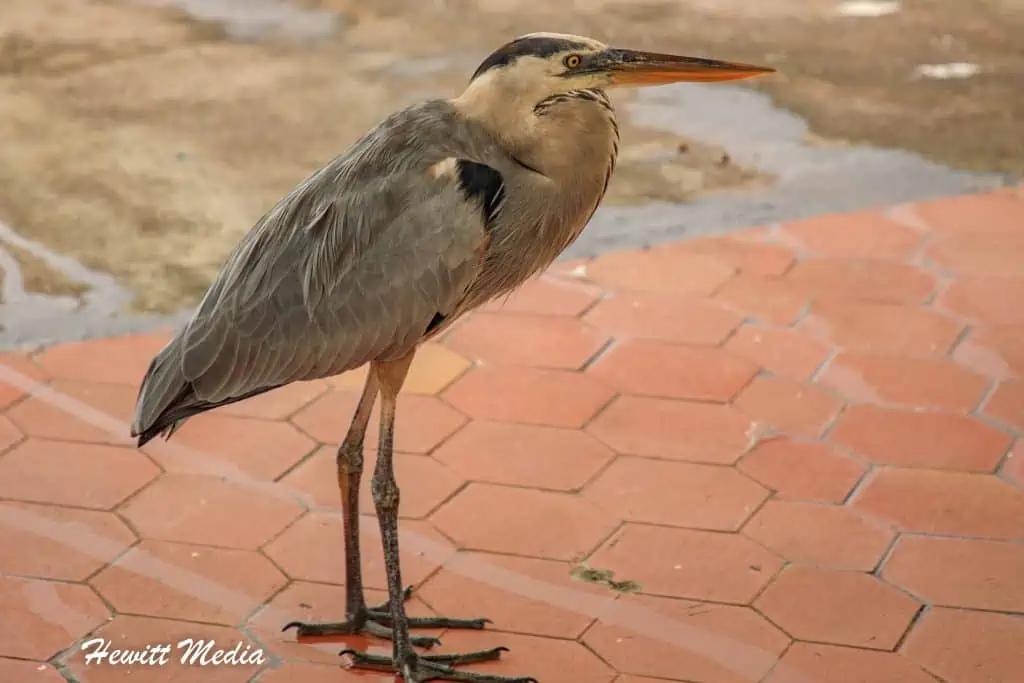
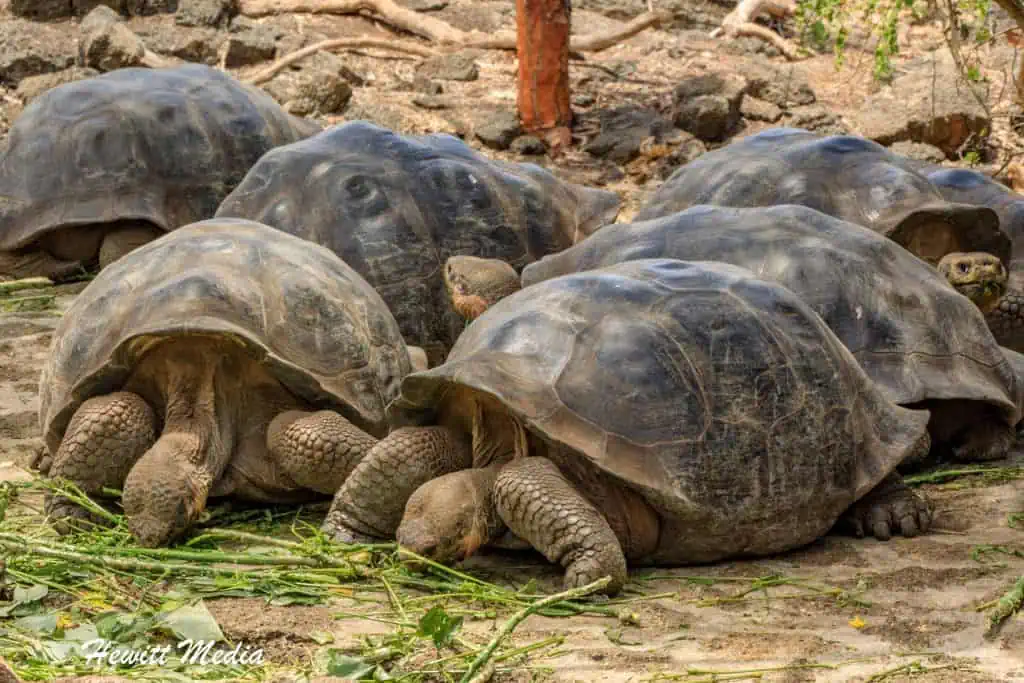
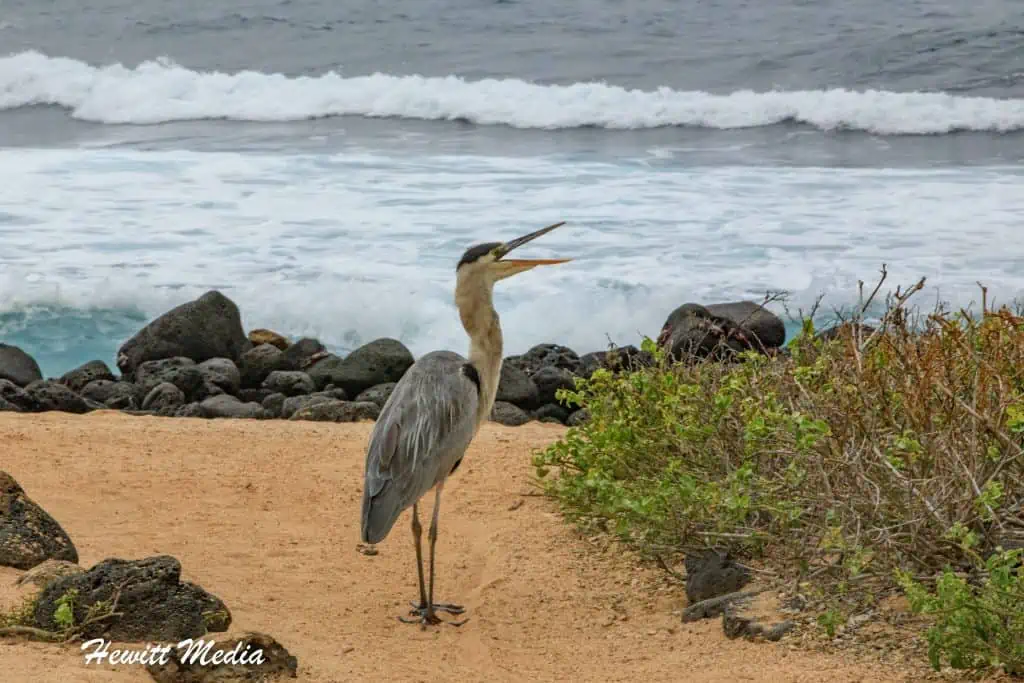
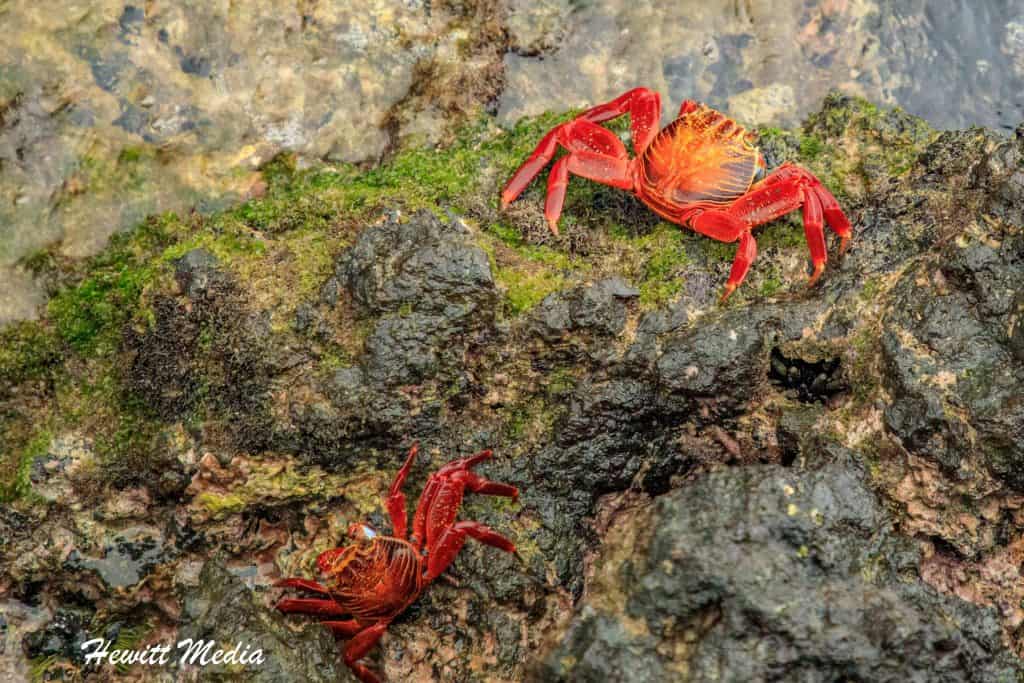
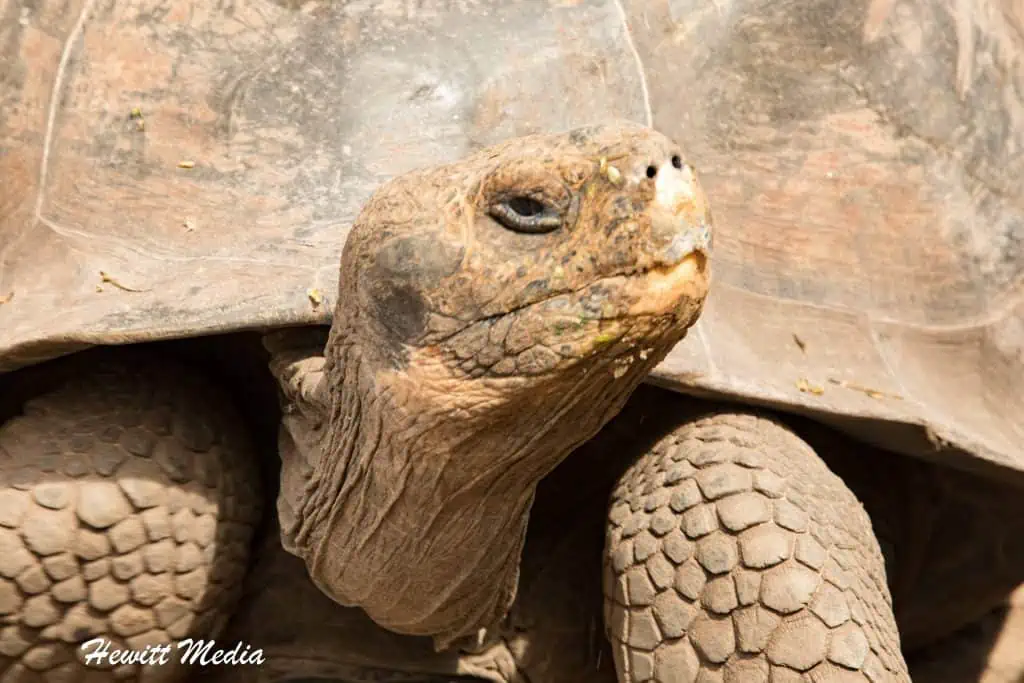
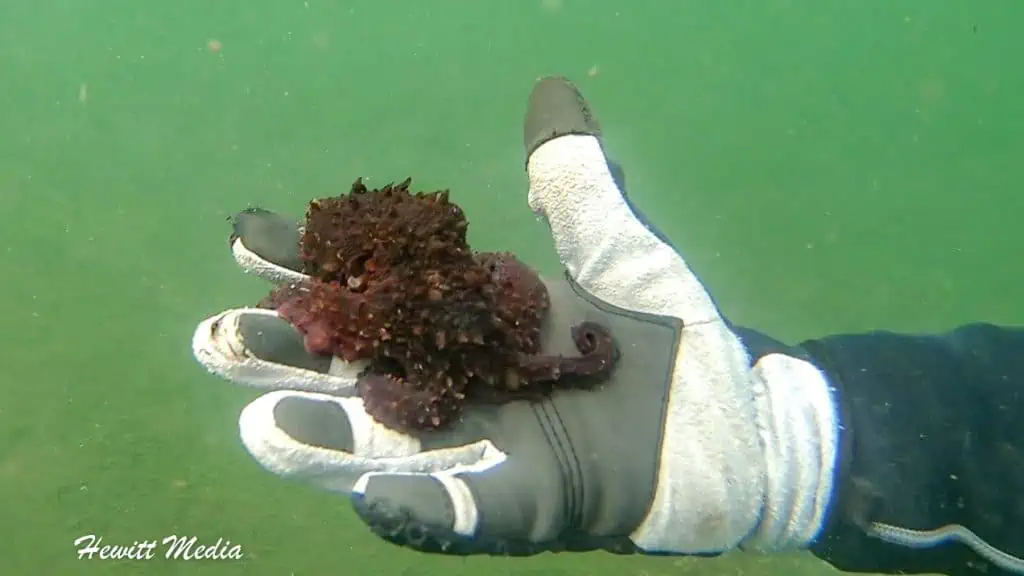
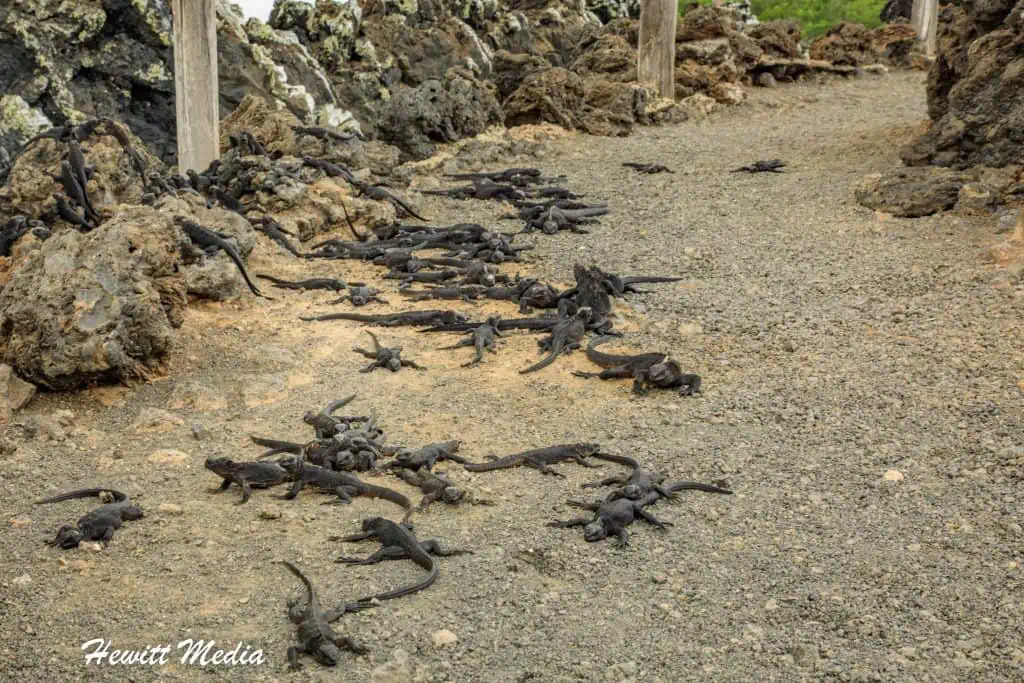
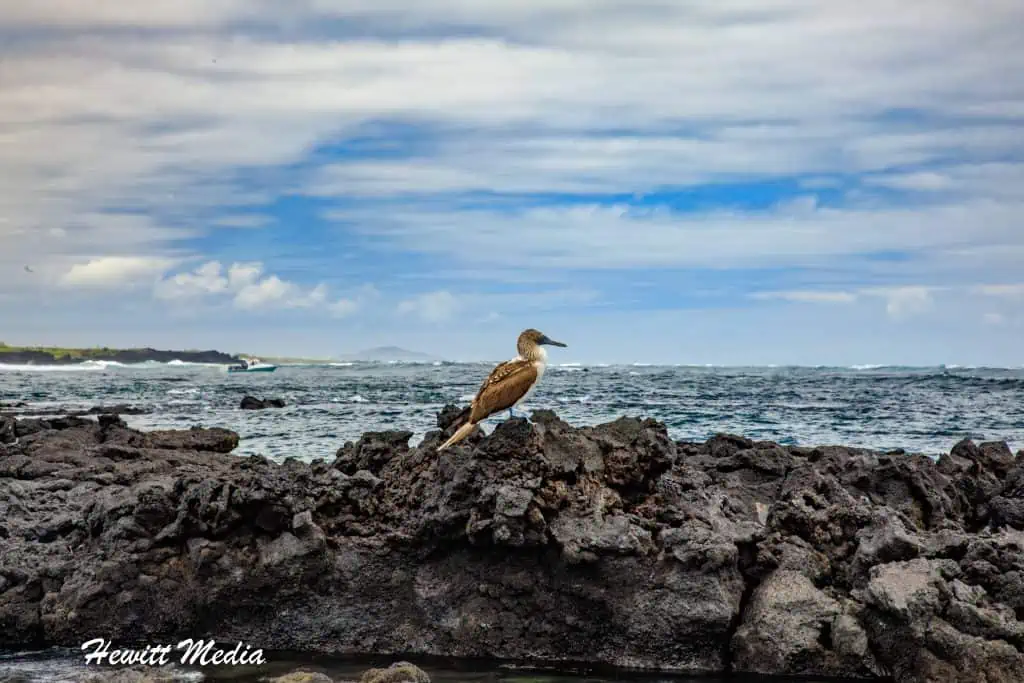
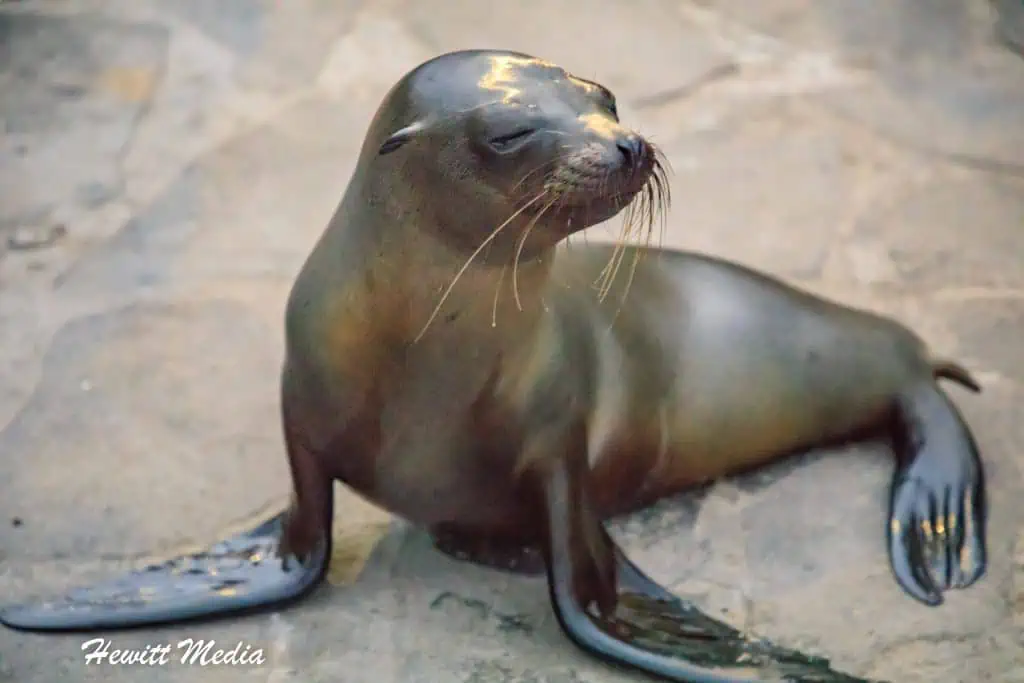
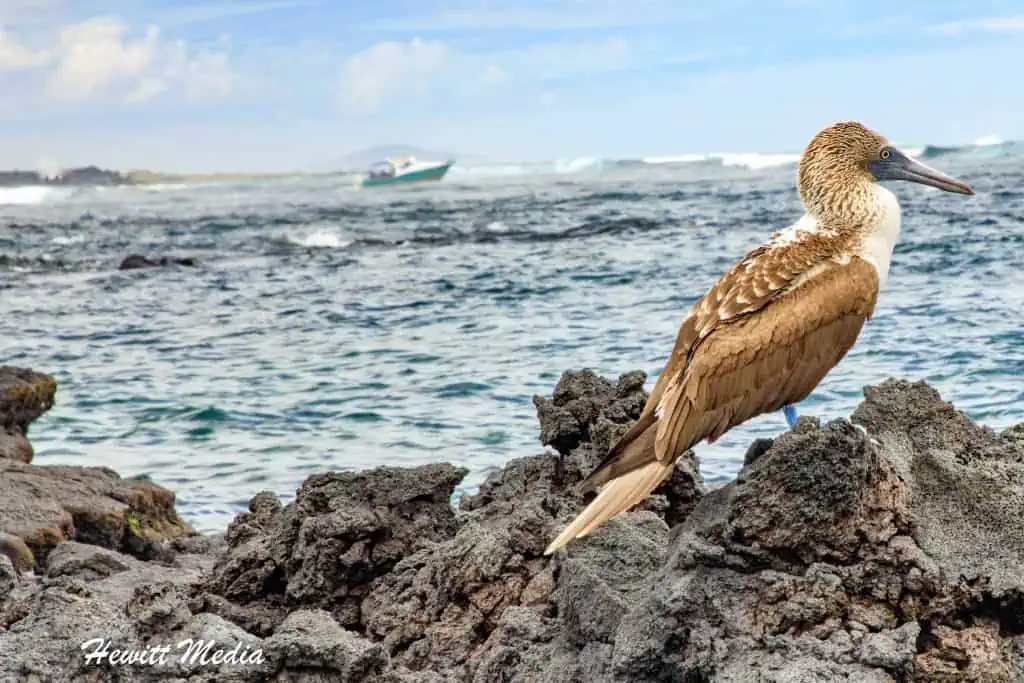
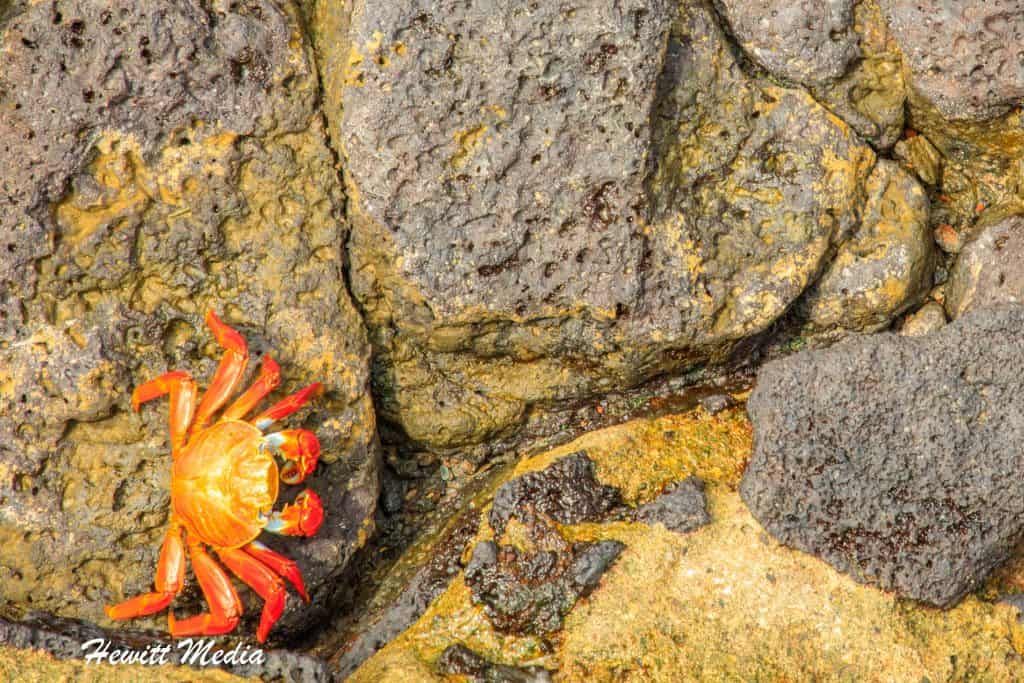
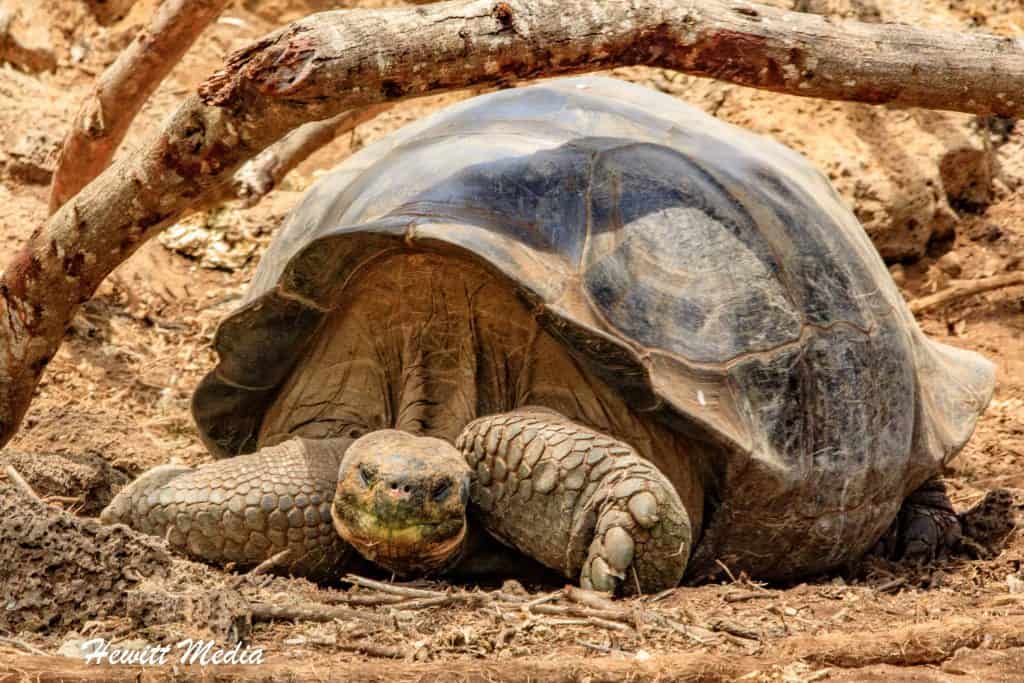
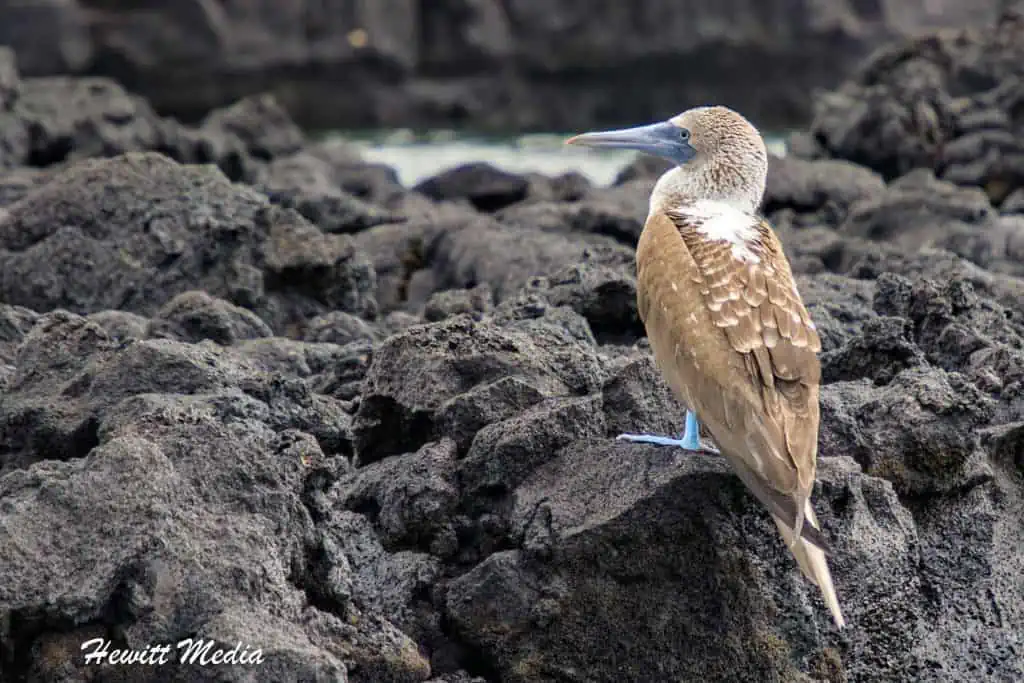
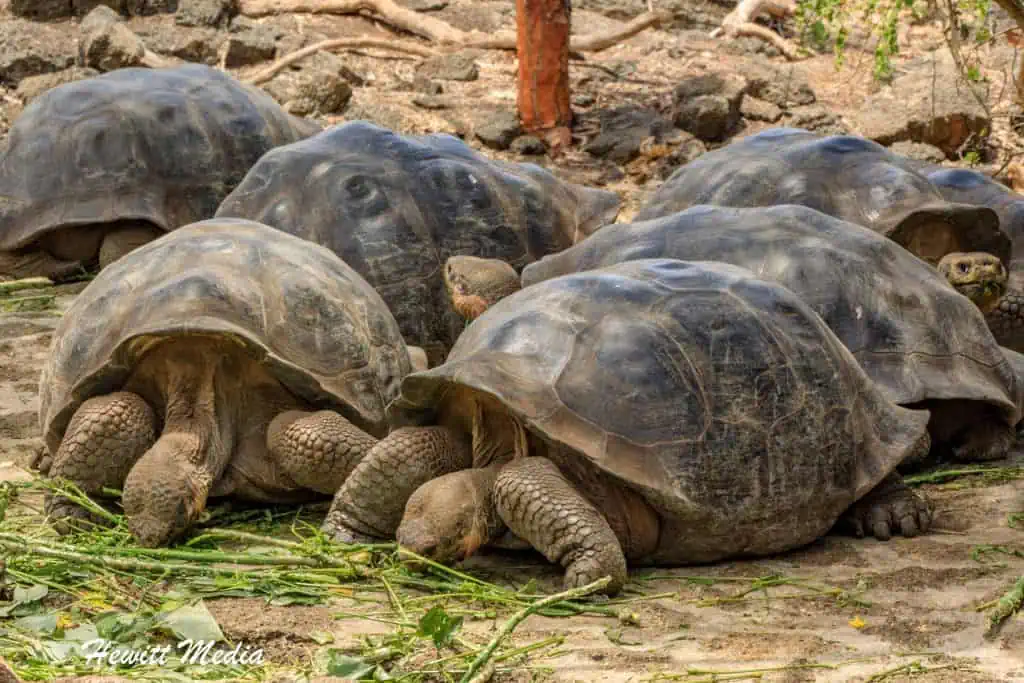

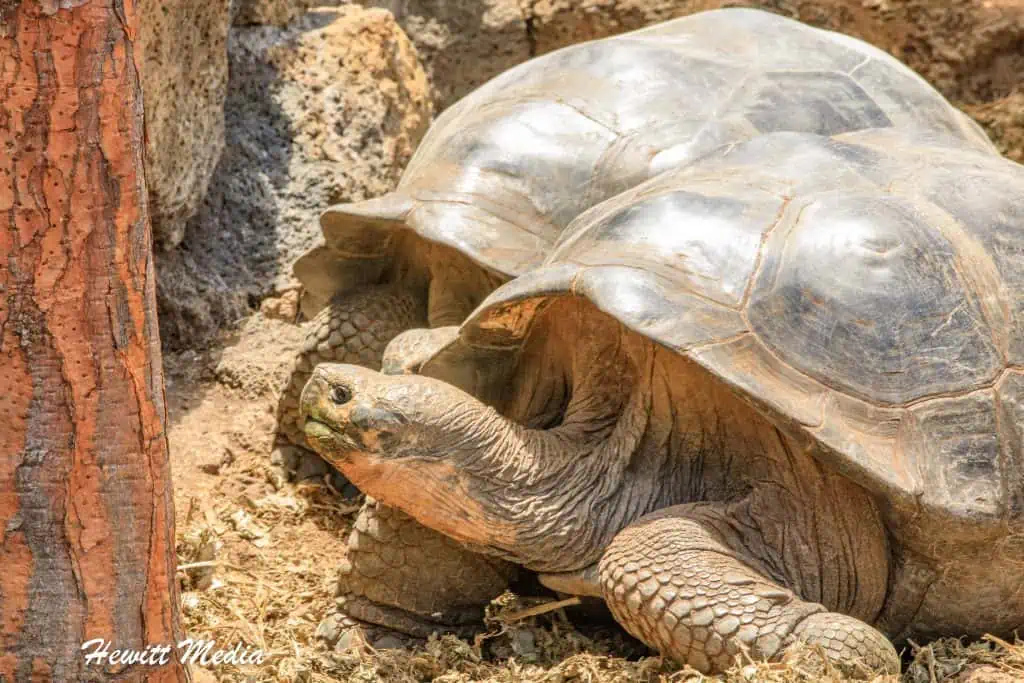
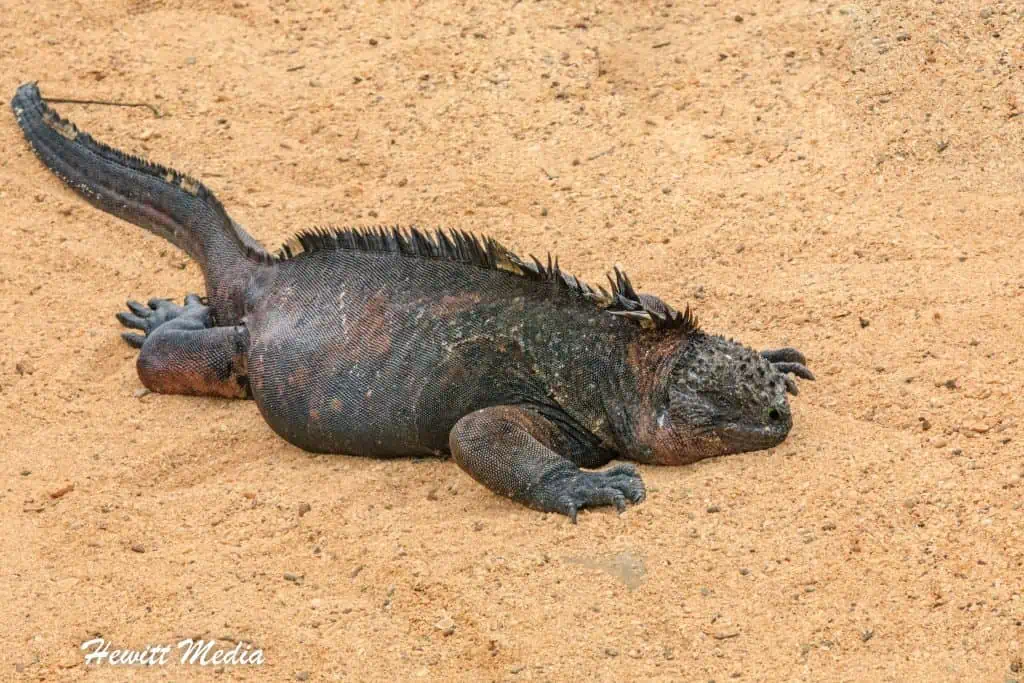
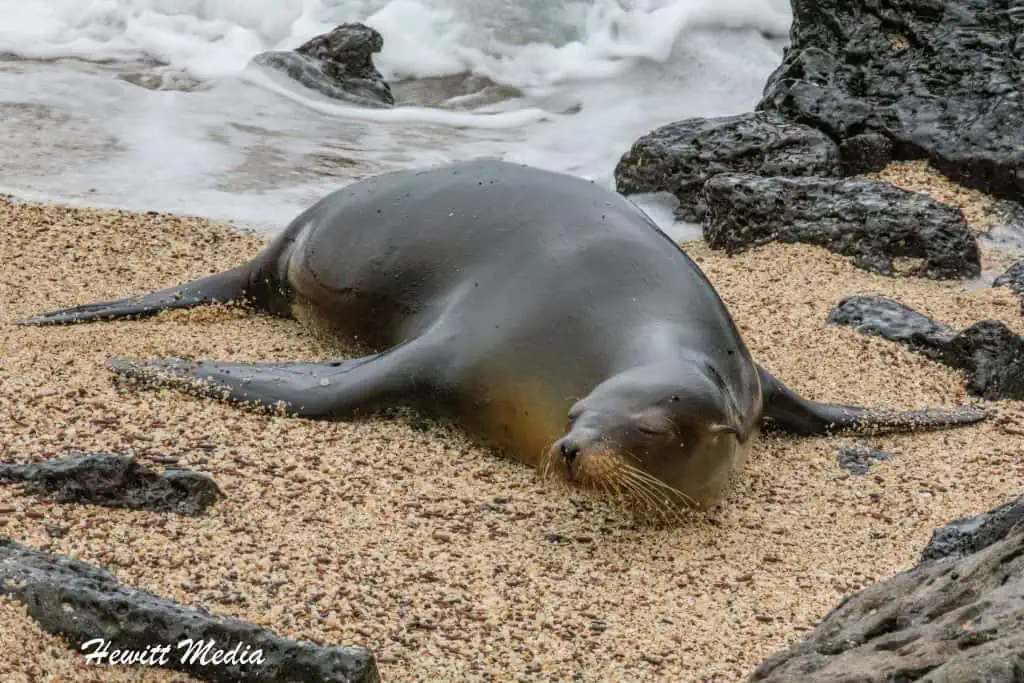

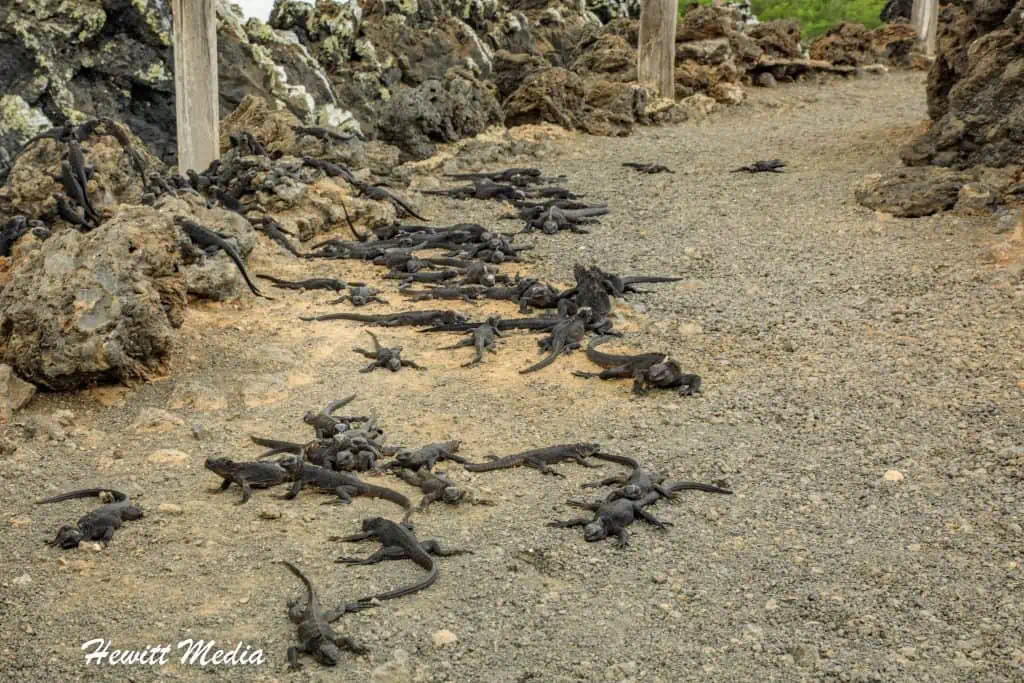
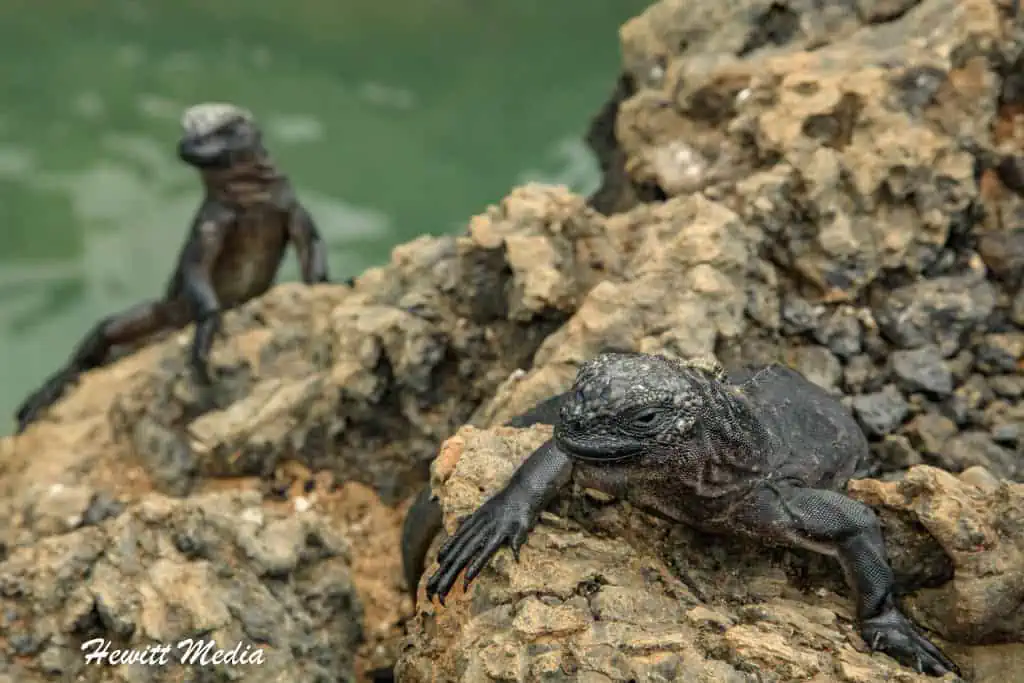
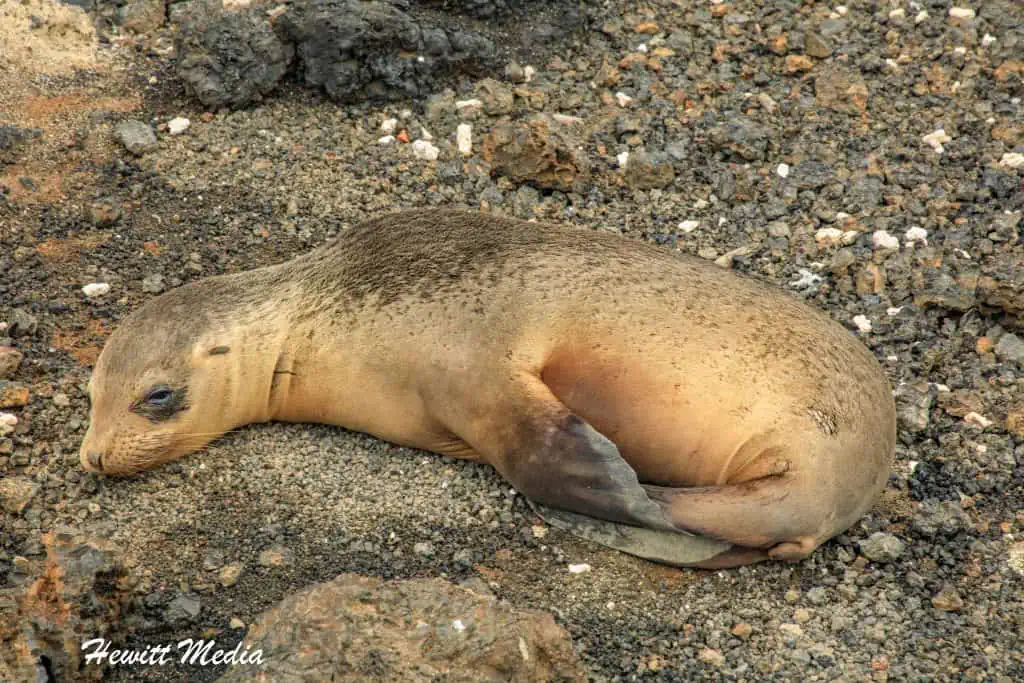
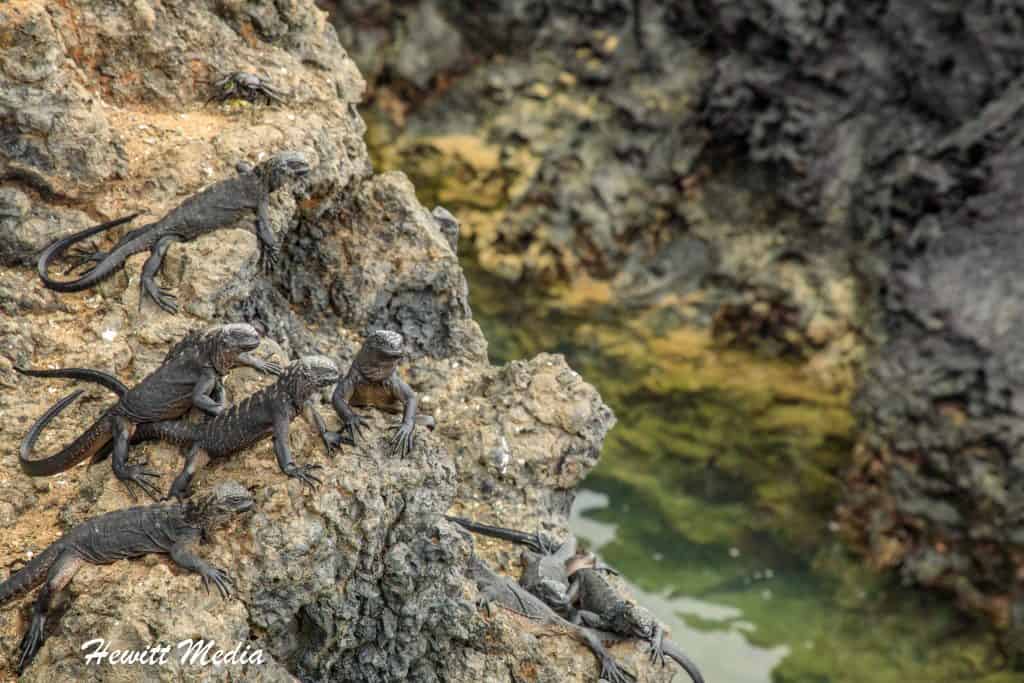
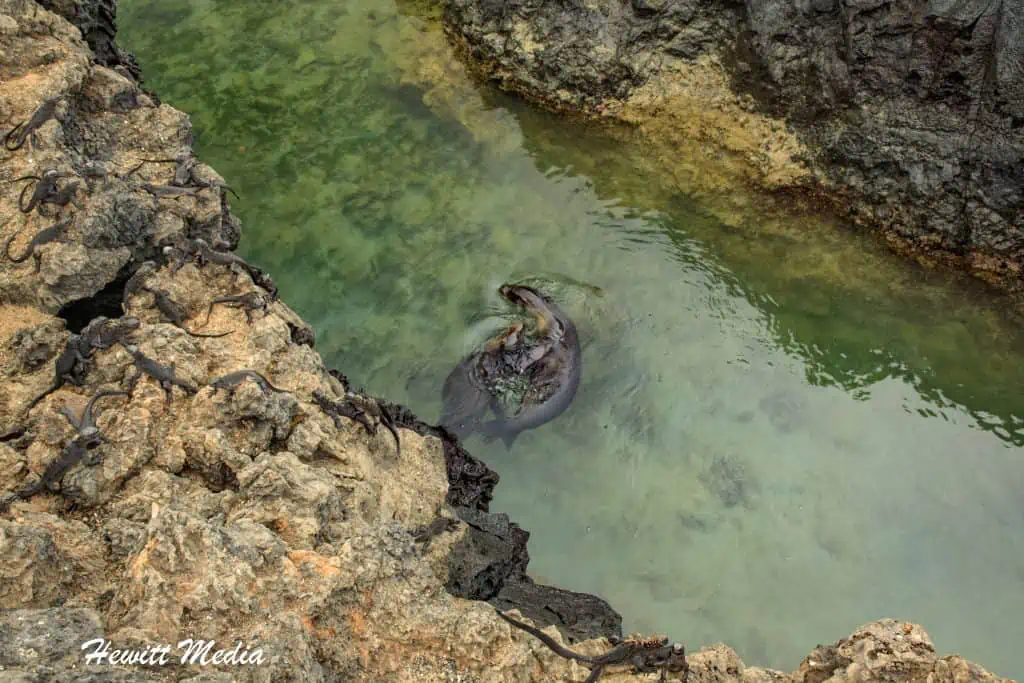
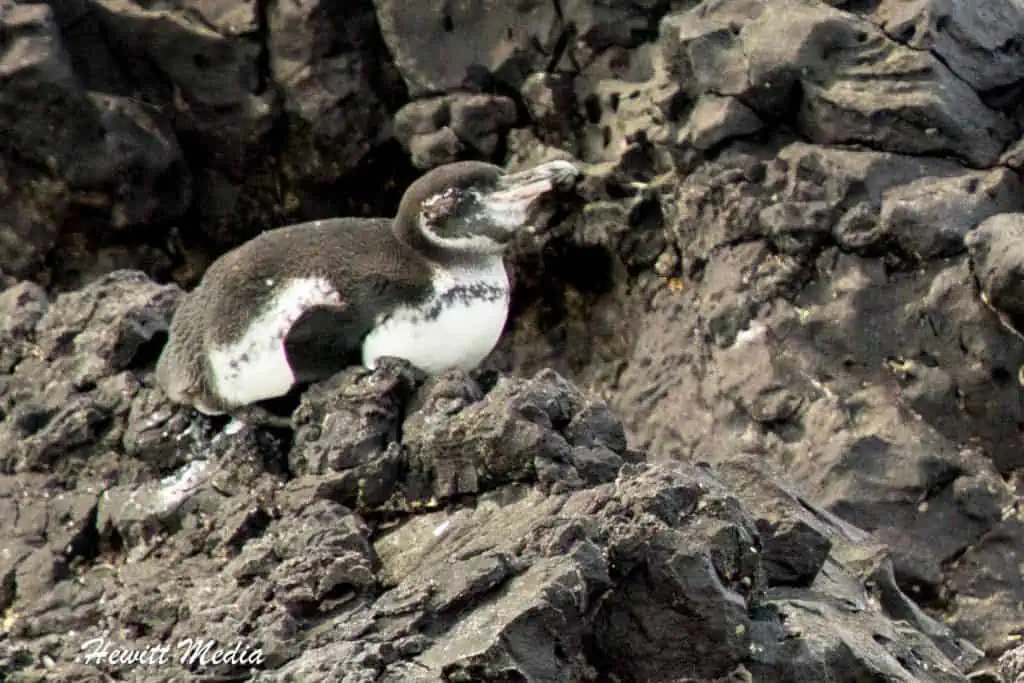
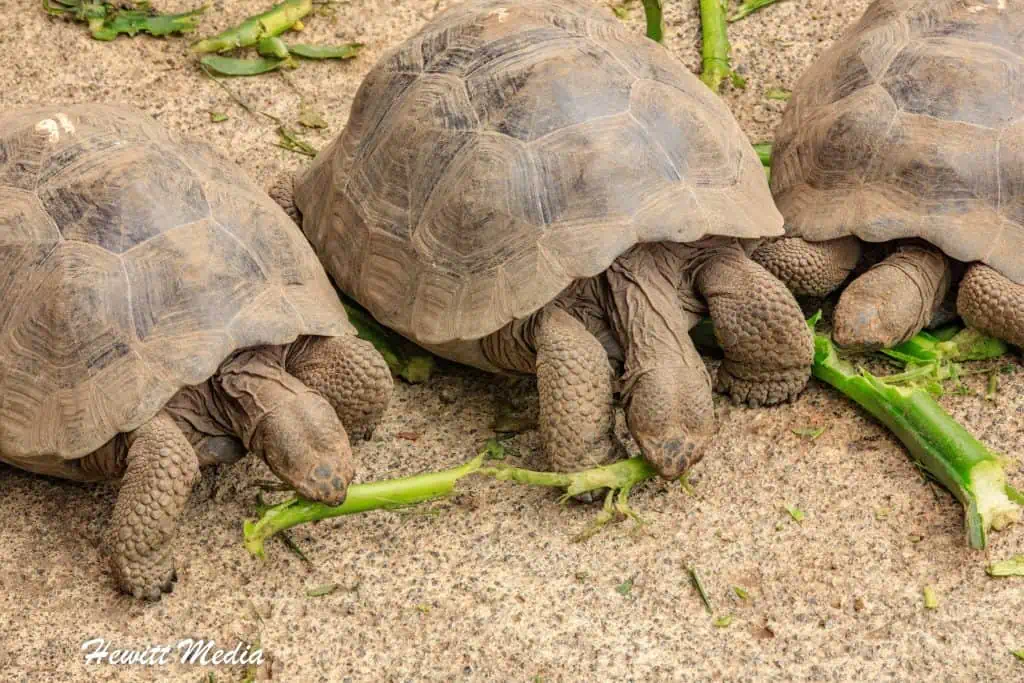
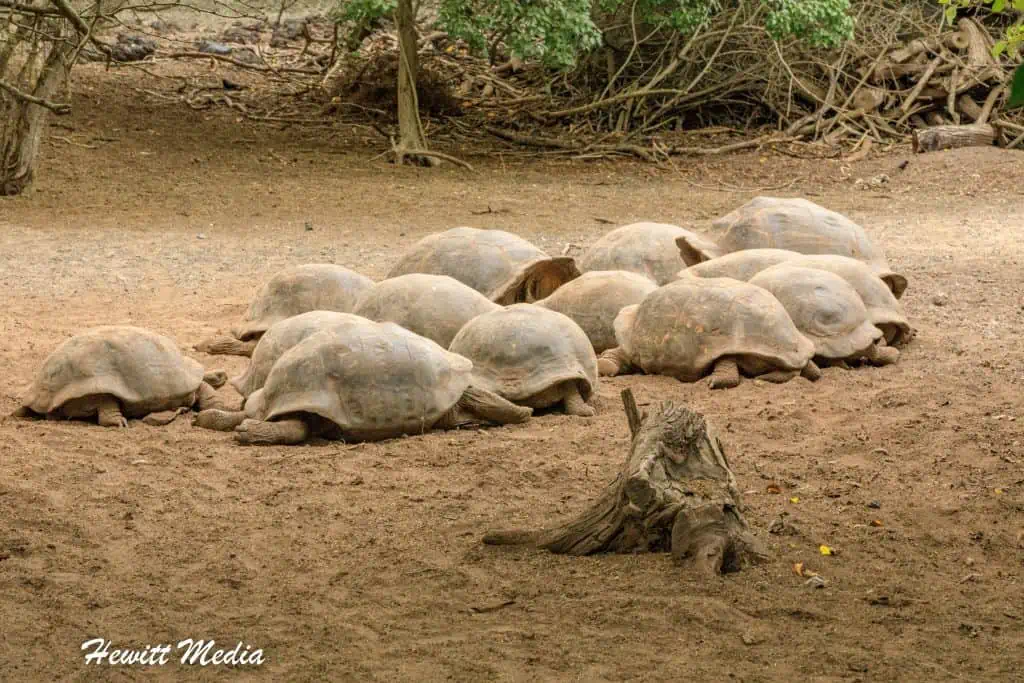
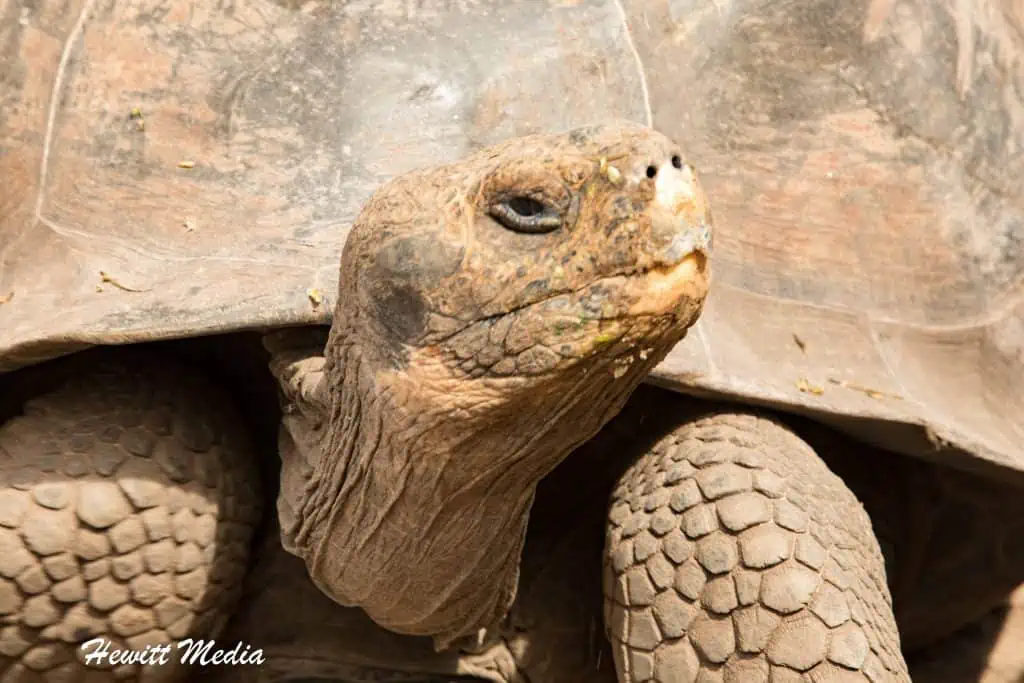
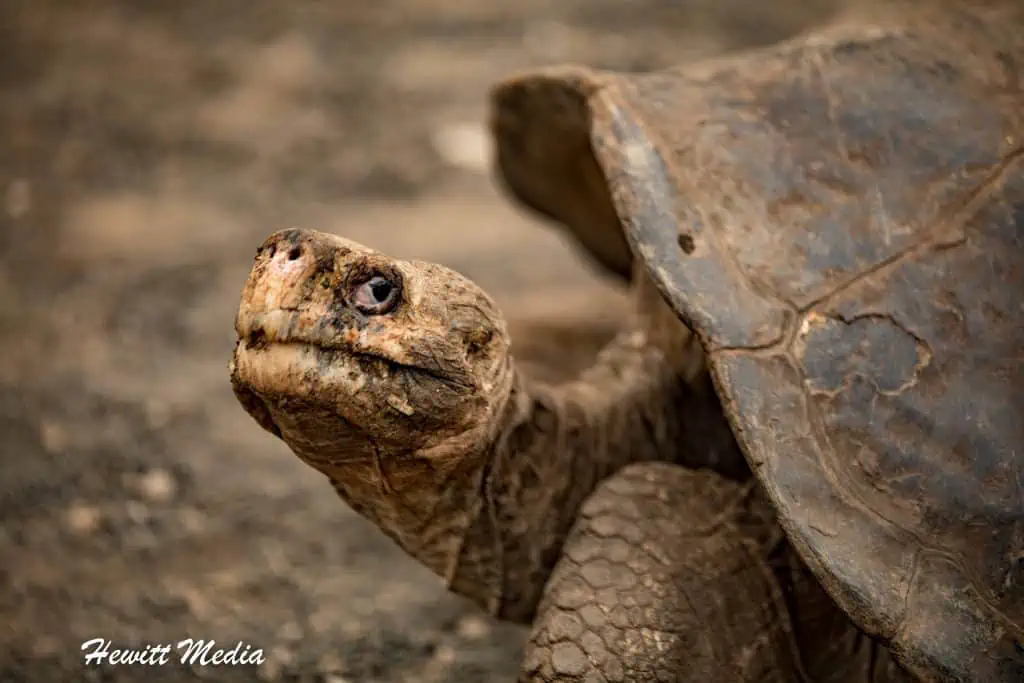
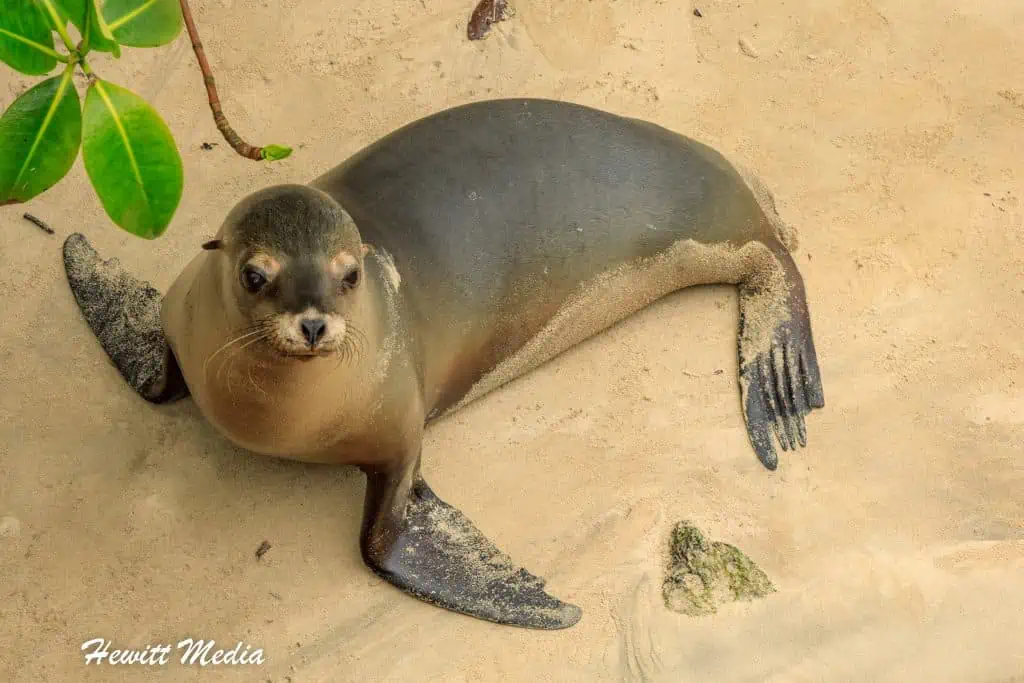
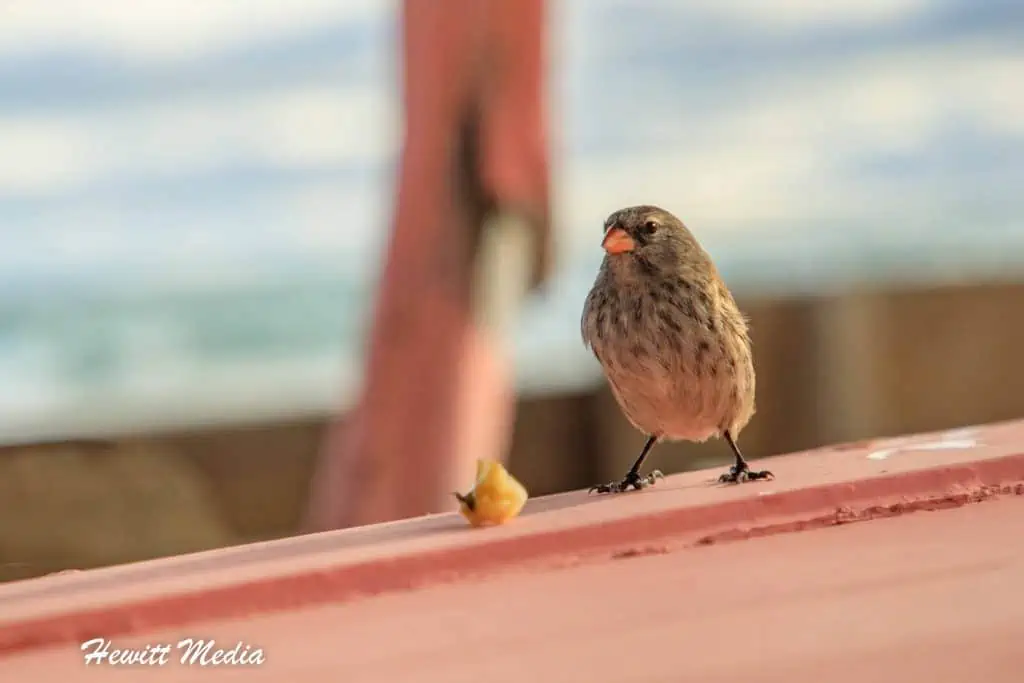
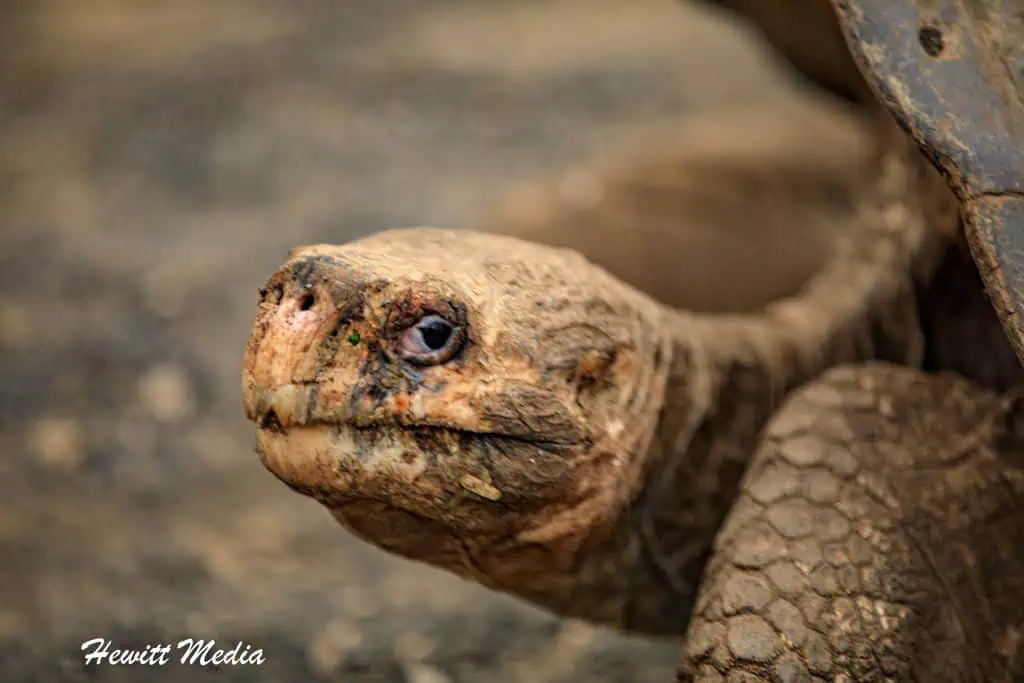
Don’t Forget to Subscribe to My Adventures!

Let Me Help You Save On Your Next Adventure!
‘Start Exploring Today’ Merchandise Available Now!








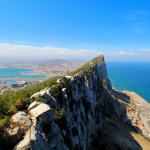
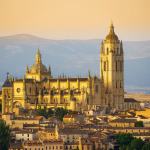


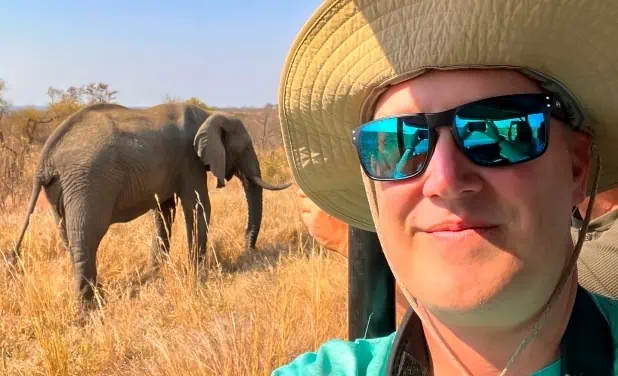
My grandparents recently visited the Galapagos and loved it. Thank you for all the information!
No problem! It is an amazing place!
WOW! Such fabulous diversity of wildlife. You must have been in heaven! Thanks for your fabulous photos. Mel
Thanks Mel!! It was amazing!
This is such a wonderful collection of photos, maps, and information. I’m hoping to visit the Galapagos one day. I taught a lot about Darwin’s study using finches and how their bill size and shape was related to what they ate and how different ones survived on different islands based on the food source. Fascinating!
Thank you so much!! I hope you get to make that trip one day. It is such an amazing place!
Heading to the Galapagos on Wednesday and I’ll definitely be using this guide! So useful, thank you 🙂
Awesome!!! Have a blast on your trip!! 👍